转载:原文 http://www.eefocus.com/antaur/blog/17-08/423751_6cc0d.html
0. 引言
通过之前的学习,可以在PL端创建从机模式的AXI接口IP核。但是从机模式是被动接收数据,而不能主动的去获取数据,因此计划研究一下AXI Master接口的IP核的构建方法。
1. 利用向导创建AXI Lite Master测试用例
在这一步,AXI类型为Lite型的,可选参数如下所示:
在这里,重点是Interface Mode,前面的实验中采用的是默认配置Slave,即设计的IP接口为从机。本实验中,要将其设置为Master。
下面的三个参数跟Sl**e模式下可配置的参数类型是相同的。具体的说明如下所示:
Data Width:为数据总线的位宽,单位为bits
Memory Size:只有在IP类型为AXI FULL Slave模式下才有效,目前不讨论。
Number of Registers:只有在IP接口类型为AXI Lite Slave模式下才有效,可以参看之前的实验说明。
至此,利用向导工具创建一个AXI Lite Master类型的IP接口配置完毕。
2. 源码分析
2.1 顶层源码解析
系统会自动生成一个该IP的工程,可以查看生成的源代码,并在此基础上进行修改。
从上图可以看出,向导工具就生成了两个模块。直接综合后,查看RTL级图的操作入口如下所示:
显示结果如下:
可以看出顶层模块只是做了简单的直连封装,内部没有任何逻辑设计,查看代码(附录1)也是如此,唯一有用的操作配置了内层模块实例的参数。
具体配置测参数如下所示:
可以看到配置了5个参数,其中:
C_M00_AXI_ADDR_WIDTH表示地址总线的位宽,这里配置为32bits,由于涉及到总线的协议,建议不要动这个参数。
C_M00_AXI_DATA_WIDTH表示数据总线的位宽,这里配置为32bits,同样的原因,建议不要动这个参数。
其余的三个参数是根据测试用例的用户逻辑相关的,具体意义在底层模块的源码分析(附录2)中会详细解释,这里简单说明一下:
C_M00_AXI_TARGET_SLAVE BASE_ADDR表示本IP作为主机欲访问的从机内存的基地址。
C_M00_AXI_START_DATA_VALUE表示对从机寄存器进行写入操作的测试数据
C_M00_AXI_TRANSACTIONS_NUM表示测试的次数
具体逻辑及各参数的意义见下文对底层模块的解析。
2.2 底层源码解析
向导自动生成的示例程序中底层模块为AzIP_AXI_Master_Ex1_v1_0_M00_AXI,该模块并不是一个Master型的IO标准接口,而只是一个用户测试用例的逻辑操作。而Master的Write和Read读写逻辑并没有很完毕的封装,需要仔细分析示例代码进行拆分。
具体的代码解析详见后面附录2的注释说明,这里给出的仅是本人对此分析得到的笔记。
- 测试业务逻辑
测试业务逻辑的本质如下图所示,就是一个典型的内存读写操作的测试流程。
代码编写时采用状态机的方式。
其中:
【地址操作分析】:
从机寄存器的初始地址有变量C_M00_AXI_TARGET_SLAVE_BASE_ADDR定义,在构建集成系统时,对应从机的内存映射必须于配置相同。
AXI总线上写操作地址总线绑定如下,C_M00_AXI_TARGET_SLAVE_BASE_ADDR为基地址,而axi_awaddr定义地址偏移量。
段内地址偏移量初始化值为0,每次写入成功后,地址偏移量+4,这是因为地址定义的单位是字节Byte,而数据总线为32bits,即4个字节,因此没写入32bits,会用掉从机4个地址的存储空间。
关于读取操作指定寄存器的地址定义及处理过程是类似的。
【数据操作分析】:
写操作使用的数据总线绑定到一个内部寄存器上。
初始化时,测试数据寄存器被设置为参数配置的数值,之后每次加1。
测试数据向从机写入之后,内部备份保存一份,存在寄存器expected_rdata中,代码如下:
可以看到代码逻辑完全相同,但是整个代码架构真的不敢苟同。
数据比较段的代码如下:
相应的逻辑应该是一旦有一次出错,read_mismatch就置为1,如果下次对了,该状态寄存器仍然保持数据为1,直到复位操作。
(2)AXI4-Lite总线接口定义
在进行AXI4-Lite总线读写时序操作时,首先要明确总线的读写操作接口。
查看相关技术文档,这里主要用到以下两个技术文档:
- ARM公司发布的《ARM AMBA AXI Protocol v2.0 Specification》
- Xilinx公司发布的《Vivado Design Suite : AXI Reference Guide》UG1037(v3.0)2015
可以看到,无论是AXI4总线还是精简版的AXI4-Lite总线接口分成5大类,这5大类又分别****于Write操作核Read操作。
Write操作
- 写地址:主机-->从机
- 写数据:主机-->从机
- 写应答:从机-->主机
Read操作
- 读地址:主机-->从机
- 读数据:从机-->主机
下面重点研究一下AXI4-Lite总线具体是如何定义的,它与AXI4总线协议有什么不同?
首先看一下AXI4总线协议的官方定义:
再看一下AXI4-Lite总线协议的官方定义:
不支持突发(burst)传输模式,及burst length=1
数据总线宽度只能为32bit或则64bits
不支持独家访问(exclusive accesses)
即AXI4-Lite不支持突发(burst)传输模式。
【说明】关于突发(burst)传输模式是否采用将在后面分析读写时序时重点讨论。这里先铺垫一下。
AXI4总线,由于读写通道是分离的,可以提供实时双向的数据传输。
采用突发(burst)传输模式,可以在发送1个地址之后,最多支持突发256words的数据。(Words??2字节吗??)
下面看一下AXI4-Lite总线协议的物理接口Port的定义:
可以看出除了时钟和复位信号后,也是前文介绍的5类信号通道。
但是作为一个简化的总线协议,其物理接口应该比完整版的AXI4总线要少,具体精简掉了哪些?详见下表。
学习完原理性的基础知识之后,我们来看一下示例程序代码是否符合官方标准。
分析AXI Master示例IP源代码的Port定义,代码即注释说明如下所示:
【AXI4-Lite Write Address Channel】
在示例程序中,AXI Master模块的M_AXI_AWPROT管脚始终输出为:3’b000
【AXI4-Lite Write data Channel】
其中端口M_AXI_ARPROT,参见【AXI4-Lite Write Address Channel】中的M_AXI_AWPROT
【AXI4-Lite Read Data Channel】
在示例程序中,AXI Master模块由于数据总线位宽为32bit,因此M_AXI_WSTRB管脚始终输出为:4’b1111
【AXI4-Lite Write response Channel】
【AXI4-Lite Read Address Channel】
其中端口M_AXI_ARPROT,参见【AXI4-Lite Write Address Channel】中的M_AXI_AWPROT
【AXI4-Lite Read Data Channel】
其中端口M_AXI_RRESP,参见【AXI4-Lite Write response Channel】中的M_AXI_BRESP
其中端口M_AXI_RRESP,参见【AXI4-Lite Write response Channel】中的M_AXI_BRESP
(3)AXI4-Lite总线读写时序分析1--写入操作时序
研究总线协议的交互时序,必须依赖协议标准,但是能够查到的官方协议标准均没有对AXI4-Lite总线的读写时序进行独立的时序设定。
Xilinx公司发布的文档,引用的还是ARM公司发布的文档,对于总线写入时序逻辑示意图如下:
表示,主机需要先写地址,然后写入一系列数据,为什么是四个暂时不确定,从机处理完毕后回复一个应答响应。
ARM公司发布的文档《ARM AMBA AXI Protocol v2.0 Specification》中没有AXI4-Lits的写入时序逻辑,只有Write brust的时序示意图。如下所示
经过前面的研究,知道AXI4-Lite是brust length=1的Write brust,因此我自行简化上述时序图如下:
如果主机连续发送两次数据写入操作,我猜测的时序逻辑图应该如下所示:
分析示例程序中,AXI Master模块的源代码,绘制相应的主机向从机写入数据的时序逻辑如下图所示:
查看代码,分析得到的时序与个人分析得到的原理时序并不完全匹配。这里先铺垫一下,后文将会对示例源码的时序进行仿真分析,得到对应可用的时序,用于将来自行编写接口时使用。记得看下文。
(4) AXI4-Lite总线读写时序分析2--读取操作时序
同样先学习一下官方协议。
以及来自官方文档的读取操作时序图。
同样自行分析对于brust length=1的AXI4-Lite总线,读取操作的时序图如下所示
示例代码的操作时序这里就不在画处理流程图了。下文会通过时序仿真给出示例中采用的时序关系。
(5) 示例工程的时序分析
【工程创建的原始出发点】:
根据上述对AXI4-Lite总线接口的分析,其实就是主机和从机之间的数据通信。联想到之间创建的AXI4-Lite Sl**e示例IP核,是否能创建一个顶层模块直接将AXI4-Lite Sl**e示例IP核与AXI4-Lite Sl**e示例IP核直接相连,完成AXI4-Lite总线读写操作?
为了验证上述想法,首先再创建一个AXI4-Lite Sl**e示例IP核,参数要与AXI4-Lite Master示例IP核的参数向对应,下面将端口定义对比如下:
从上图的对比中,可以看出AXI4-Lite主从机的接口其实是一一匹配的。
创建一个顶层文件Top_AXI4_Lite_Interfce_Demo,将生成的主从示例直接对连。代码见附录3.相应的层级结构如下图所示。
综合完的RTL级连接图如下所示。
对该顶层文件创建仿真驱动,代码如下所示:
`timescale 1ns / 1ps
module Sim_AXI4_Lite_Interface();
reg axi_ACLK; // AXI总线时钟
reg axi_ARESETn; // 系统复位信号,低电平有效
reg r_app_txn; // 应用级复位信号,负脉冲,上升沿复位
wire w_err; // 状态指示,异常
wire w_txn_done; // 状态指示,发送完毕
Top_AXI4_Lite_Interfce_Demo Ut1 (
.axi_ACLK(axi_ACLK),
.axi_ARESETn(axi_ARESETn),
.app_TXn(r_app_txn),
.state_err(w_err),
.state_done(w_txn_done)
);
parameter PERIOD = 2;
always begin
#(PERIOD/2);
axi_ACLK = ~axi_ACLK;
end
initial begin
axi_ACLK = 1'b0;
axi_ARESETn = 1'b1;
r_app_txn = 1'b1;
#(10*PERIOD);
axi_ARESETn = 1'b0;
#(5*PERIOD);
r_app_txn = 1'b0;
#(2*PERIOD);
axi_ARESETn = 1'b1;
#(4*PERIOD);
r_app_txn = 1'b1;
end
endmodule
运行后的仿真结果如下所示:
仿真结果1:先写入4次,然后读取4次的时序仿真结果
仿真结果2:先写入1次,然后读取1次的时序仿真结果
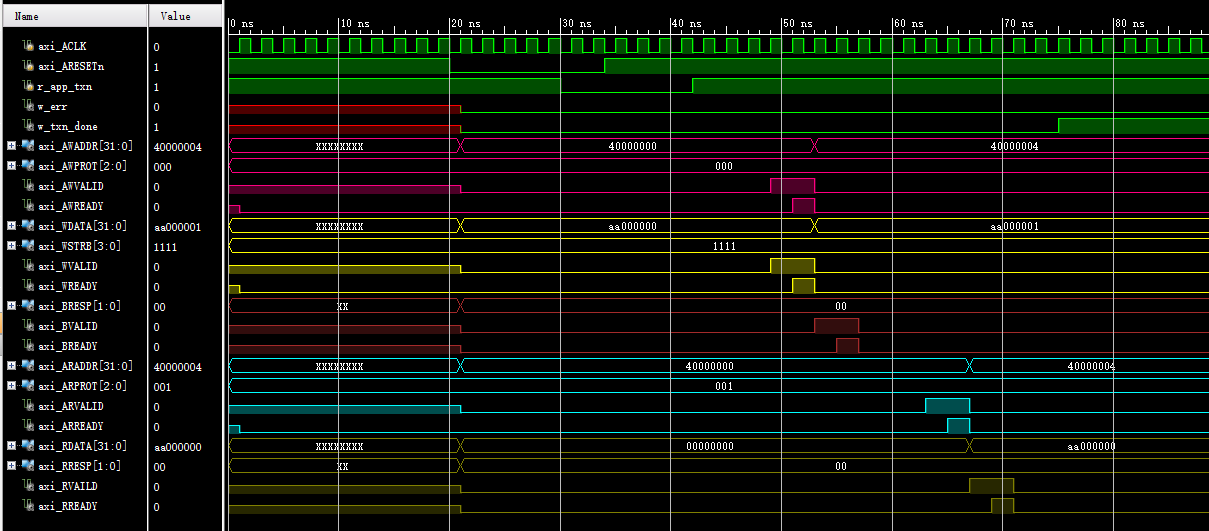
仿真结果3:仅写入1次时序仿真结果
仿真结果4:仅读取1次时序仿真结果
仿真结果5:先写入2次,再读取2次时序仿真结果
- 对比仿真得到的写入操作时序和从官网文档分析得到的时序
【个人心得】
可以看出,AXI4中设定的5类通道都是相互独立的,示例仿真中,应为AWVALID和WVALID是同时给从机的,从机就同时采样AWADDR总线和WDATA总线数据,并同时给出了应答AWREADY和WREADY。
从机在匹配完Address和Data后,给出应答BVALID。
而官方文档上的时序时先发地址后发数据,正常的从机也是能够正确响应的。
结论,自行编写接口时,每个通道要独立处理,不要耦合到一起。
- 对比仿真得到的读取操作时序和从官网文档分析得到的时序
【个人心得】
由于没有经过总线控制器,而是直连的,因此时序仿真结果图中从机的响应速度很快,而原理图中有个响应处理延时。
2. 总结
通过本学习笔记,详细分析了AXI4-Lite总线主机端的交互处理时序,以后就可以自行编写主从机的接口了。
附录1:顶层模块源代码:
`timescale 1ns / 1ps
module Top_AXI4_Lite_Interfce_Demo
#(
parameter C_AXI_START_DATA_VALUE = 32'hAA000000,
parameter C_AXI_TARGET_SLAVE_BASE_ADDR = 32'h40000000,
parameter integer C_AXI_ADDR_WIDTH = 32,
parameter integer C_AXI_DATA_WIDTH = 32,
parameter integer C_AXI_TRANSACTIONS_NUM = 4
)
(
input axi_ACLK,
input axi_ARESETn,
input app_TXn,
output state_err,
output state_done
);
wire w_err; // 状态指示,异常
wire w_txn_done; // 状态指示,发送完毕
assign state_err = w_err;
assign state_done = w_txn_done;
wire [C_AXI_ADDR_WIDTH-1 : 0] axi_AWADDR; // AXI总线信号:AWADDR
wire [2 : 0] axi_AWPROT; // AXI总线信号:AWPROT
wire axi_AWVALID; // AXI总线信号:AWVALID
wire axi_AWREADY; // AXI总线信号:AWREADY
wire [C_AXI_DATA_WIDTH-1 : 0] axi_WDATA; // AXI总线信号:WDATA
wire [C_AXI_DATA_WIDTH/8-1 : 0] axi_WSTRB; // AXI总线信号:WSTRB
wire axi_WVALID; // AXI总线信号:WVALID
wire axi_WREADY; // AXI总线信号:WREADY
wire [1 : 0] axi_BRESP; // AXI总线信号:BRESP
wire axi_BVALID; // AXI总线信号:BVALID
wire axi_BREADY; // AXI总线信号:BREADY
wire [C_AXI_ADDR_WIDTH-1 : 0] axi_ARADDR; // AXI总线信号:ARADDR
wire [2 : 0] axi_ARPROT; // AXI总线信号:ARPROT
wire axi_ARVALID; // AXI总线信号:ARVALID
wire axi_ARREADY; // AXI总线信号:ARREADY
wire [C_AXI_DATA_WIDTH-1 : 0] axi_RDATA; // AXI总线信号:RDATA
wire [1 : 0] axi_RRESP; // AXI总线信号:RRESP
wire axi_RVAILD; // AXI总线信号:RVAILD
wire axi_RREADY; // AXI总线信号:RREADY
axi_ip_master_v1_0 #
(
.C_M00_AXI_START_DATA_VALUE(C_AXI_START_DATA_VALUE),
.C_M00_AXI_TARGET_SLAVE_BASE_ADDR(C_AXI_TARGET_SLAVE_BASE_ADDR),
.C_M00_AXI_ADDR_WIDTH(C_AXI_ADDR_WIDTH),
.C_M00_AXI_DATA_WIDTH(C_AXI_DATA_WIDTH),
.C_M00_AXI_TRANSACTIONS_NUM(C_AXI_TRANSACTIONS_NUM)
) Ut1 (
//-- AXI4-Lite Global ----------------------------------------------
.m00_axi_aclk(axi_ACLK),
.m00_axi_aresetn(axi_ARESETn),
//------------------------------------------------------------------
.m00_axi_init_axi_txn(app_TXn),
.m00_axi_error(w_err),
.m00_axi_txn_done(w_txn_done),
//--- AXI4-Lite Write Address Channel ------------------------------
.m00_axi_awaddr(axi_AWADDR),
.m00_axi_awprot(axi_AWPROT),
.m00_axi_awvalid(axi_AWVALID),
.m00_axi_awready(axi_AWREADY),
//--- AXI4-Lite Write data Channel ------------------------------
.m00_axi_wdata(axi_WDATA),
.m00_axi_wstrb(axi_WSTRB),
.m00_axi_wvalid(axi_WVALID),
.m00_axi_wready(axi_WREADY),
//--- AXI4-Lite Write response Channel ------------------------------
.m00_axi_bresp(axi_BRESP),
.m00_axi_bvalid(axi_BVALID),
.m00_axi_bready(axi_BREADY),
//--- AXI4-Lite Read Address Channel ------------------------------
.m00_axi_araddr(axi_ARADDR),
.m00_axi_arprot(axi_ARPROT),
.m00_axi_arvalid(axi_ARVALID),
.m00_axi_arready(axi_ARREADY),
//--- AXI4-Lite Read Data Channel ------------------------------
.m00_axi_rdata(axi_RDATA),
.m00_axi_rresp(axi_RRESP),
.m00_axi_rvalid(axi_RVAILD),
.m00_axi_rready(axi_RREADY)
);
axi_ip_slave_v1_0 #
(
.C_S00_AXI_DATA_WIDTH(C_AXI_ADDR_WIDTH),
.C_S00_AXI_ADDR_WIDTH(7)
) Ut2 (
//-- AXI4-Lite Global ----------------------------------------------
.s00_axi_aclk(axi_ACLK),
.s00_axi_aresetn(axi_ARESETn),
//--- AXI4-Lite Write Address Channel ------------------------------
.s00_axi_awaddr(axi_AWADDR[6:0]), //注意:只有段地址!!!!!,做的axi_slave_ip的地址位宽为7,寄存器个数为32
.s00_axi_awprot(axi_AWPROT),
.s00_axi_awvalid(axi_AWVALID),
.s00_axi_awready(axi_AWREADY),
//--- AXI4-Lite Write data Channel --------------------------------
.s00_axi_wdata(axi_WDATA),
.s00_axi_wstrb(axi_WSTRB),
.s00_axi_wvalid(axi_WVALID),
.s00_axi_wready(axi_WREADY),
//--- AXI4-Lite Write response Channel ------------------------------
.s00_axi_bresp(axi_BRESP),
.s00_axi_bvalid(axi_BVALID),
.s00_axi_bready(axi_BREADY),
//--- AXI4-Lite Read Address Channel ------------------------------
.s00_axi_araddr(axi_ARADDR),
.s00_axi_arprot(axi_ARPROT),
.s00_axi_arvalid(axi_ARVALID),
.s00_axi_arready(axi_ARREADY),
//--- AXI4-Lite Read Data Channel ------------------------------
.s00_axi_rdata(axi_RDATA),
.s00_axi_rresp(axi_RRESP),
.s00_axi_rvalid(axi_RVAILD),
.s00_axi_rready(axi_RREADY)
);
endmodule
附录2:底层模块MASTER 顶层源代码:
`timescale 1 ns / 1 ps
module axi_ip_master_v1_0 #
(
// Users to add parameters here
// User parameters ends
// Do not modify the parameters beyond this line
// Parameters of Axi Master Bus Interface M00_AXI
parameter C_M00_AXI_START_DATA_VALUE = 32'hAA000000,
parameter C_M00_AXI_TARGET_SLAVE_BASE_ADDR = 32'h40000000,
parameter integer C_M00_AXI_ADDR_WIDTH = 32,
parameter integer C_M00_AXI_DATA_WIDTH = 32,
parameter integer C_M00_AXI_TRANSACTIONS_NUM = 4
)
(
// Users to add ports here
// User ports ends
// Do not modify the ports beyond this line
// Ports of Axi Master Bus Interface M00_AXI
input wire m00_axi_init_axi_txn,
output wire m00_axi_error,
output wire m00_axi_txn_done,
input wire m00_axi_aclk,
input wire m00_axi_aresetn,
output wire [C_M00_AXI_ADDR_WIDTH-1 : 0] m00_axi_awaddr,
output wire [2 : 0] m00_axi_awprot,
output wire m00_axi_awvalid,
input wire m00_axi_awready,
output wire [C_M00_AXI_DATA_WIDTH-1 : 0] m00_axi_wdata,
output wire [C_M00_AXI_DATA_WIDTH/8-1 : 0] m00_axi_wstrb,
output wire m00_axi_wvalid,
input wire m00_axi_wready,
input wire [1 : 0] m00_axi_bresp,
input wire m00_axi_bvalid,
output wire m00_axi_bready,
output wire [C_M00_AXI_ADDR_WIDTH-1 : 0] m00_axi_araddr,
output wire [2 : 0] m00_axi_arprot,
output wire m00_axi_arvalid,
input wire m00_axi_arready,
input wire [C_M00_AXI_DATA_WIDTH-1 : 0] m00_axi_rdata,
input wire [1 : 0] m00_axi_rresp,
input wire m00_axi_rvalid,
output wire m00_axi_rready
);
// Instantiation of Axi Bus Interface M00_AXI
axi_ip_master_v1_0_M00_AXI # (
.C_M_START_DATA_VALUE(C_M00_AXI_START_DATA_VALUE),
.C_M_TARGET_SLAVE_BASE_ADDR(C_M00_AXI_TARGET_SLAVE_BASE_ADDR),
.C_M_AXI_ADDR_WIDTH(C_M00_AXI_ADDR_WIDTH),
.C_M_AXI_DATA_WIDTH(C_M00_AXI_DATA_WIDTH),
.C_M_TRANSACTIONS_NUM(C_M00_AXI_TRANSACTIONS_NUM)
) axi_ip_master_v1_0_M00_AXI_inst (
.INIT_AXI_TXN(m00_axi_init_axi_txn),
.ERROR(m00_axi_error),
.TXN_DONE(m00_axi_txn_done),
.M_AXI_ACLK(m00_axi_aclk),
.M_AXI_ARESETN(m00_axi_aresetn),
.M_AXI_AWADDR(m00_axi_awaddr),
.M_AXI_AWPROT(m00_axi_awprot),
.M_AXI_AWVALID(m00_axi_awvalid),
.M_AXI_AWREADY(m00_axi_awready),
.M_AXI_WDATA(m00_axi_wdata),
.M_AXI_WSTRB(m00_axi_wstrb),
.M_AXI_WVALID(m00_axi_wvalid),
.M_AXI_WREADY(m00_axi_wready),
.M_AXI_BRESP(m00_axi_bresp),
.M_AXI_BVALID(m00_axi_bvalid),
.M_AXI_BREADY(m00_axi_bready),
.M_AXI_ARADDR(m00_axi_araddr),
.M_AXI_ARPROT(m00_axi_arprot),
.M_AXI_ARVALID(m00_axi_arvalid),
.M_AXI_ARREADY(m00_axi_arready),
.M_AXI_RDATA(m00_axi_rdata),
.M_AXI_RRESP(m00_axi_rresp),
.M_AXI_RVALID(m00_axi_rvalid),
.M_AXI_RREADY(m00_axi_rready)
);
// Add user logic here
// User logic ends
endmodule
附录3:底层模块MASTER 底层源代码:
`timescale 1 ns / 1 ps
module axi_ip_master_v1_0_M00_AXI #
(
// Users to add parameters here
// User parameters ends
// Do not modify the parameters beyond this line
// The master will start generating data from the C_M_START_DATA_VALUE value
parameter C_M_START_DATA_VALUE = 32'hAA000000,
// The master requires a target slave base address.
// The master will initiate read and write transactions on the slave with base address specified here as a parameter.
parameter C_M_TARGET_SLAVE_BASE_ADDR = 32'h40000000,
// Width of M_AXI address bus.
// The master generates the read and write addresses of width specified as C_M_AXI_ADDR_WIDTH.
parameter integer C_M_AXI_ADDR_WIDTH = 32,
// Width of M_AXI data bus.
// The master issues write data and accept read data where the width of the data bus is C_M_AXI_DATA_WIDTH
parameter integer C_M_AXI_DATA_WIDTH = 32,
// Transaction number is the number of write
// and read transactions the master will perform as a part of this example memory test.
parameter integer C_M_TRANSACTIONS_NUM = 4
)
(
// Users to add ports here
// User ports ends
// Do not modify the ports beyond this line
// Initiate AXI transactions
input wire INIT_AXI_TXN,
// Asserts when ERROR is detected
output reg ERROR,
// Asserts when AXI transactions is complete
output wire TXN_DONE,
// AXI clock signal
input wire M_AXI_ACLK,
// AXI active low reset signal
input wire M_AXI_ARESETN,
// Master Interface Write Address Channel ports. Write address (issued by master)
output wire [C_M_AXI_ADDR_WIDTH-1 : 0] M_AXI_AWADDR,
// Write channel Protection type.
// This signal indicates the privilege and security level of the transaction,
// and whether the transaction is a data access or an instruction access.
output wire [2 : 0] M_AXI_AWPROT,
// Write address valid.
// This signal indicates that the master signaling valid write address and control information.
output wire M_AXI_AWVALID,
// Write address ready.
// This signal indicates that the slave is ready to accept an address and associated control signals.
input wire M_AXI_AWREADY,
// Master Interface Write Data Channel ports. Write data (issued by master)
output wire [C_M_AXI_DATA_WIDTH-1 : 0] M_AXI_WDATA,
// Write strobes.
// This signal indicates which byte lanes hold valid data.
// There is one write strobe bit for each eight bits of the write data bus.
output wire [C_M_AXI_DATA_WIDTH/8-1 : 0] M_AXI_WSTRB,
// Write valid. This signal indicates that valid write data and strobes are available.
output wire M_AXI_WVALID,
// Write ready. This signal indicates that the slave can accept the write data.
input wire M_AXI_WREADY,
// Master Interface Write Response Channel ports.
// This signal indicates the status of the write transaction.
input wire [1 : 0] M_AXI_BRESP,
// Write response valid.
// This signal indicates that the channel is signaling a valid write response
input wire M_AXI_BVALID,
// Response ready. This signal indicates that the master can accept a write response.
output wire M_AXI_BREADY,
// Master Interface Read Address Channel ports. Read address (issued by master)
output wire [C_M_AXI_ADDR_WIDTH-1 : 0] M_AXI_ARADDR,
// Protection type.
// This signal indicates the privilege and security level of the transaction,
// and whether the transaction is a data access or an instruction access.
output wire [2 : 0] M_AXI_ARPROT,
// Read address valid.
// This signal indicates that the channel is signaling valid read address and control information.
output wire M_AXI_ARVALID,
// Read address ready.
// This signal indicates that the slave is ready to accept an address and associated control signals.
input wire M_AXI_ARREADY,
// Master Interface Read Data Channel ports. Read data (issued by slave)
input wire [C_M_AXI_DATA_WIDTH-1 : 0] M_AXI_RDATA,
// Read response. This signal indicates the status of the read transfer.
input wire [1 : 0] M_AXI_RRESP,
// Read valid. This signal indicates that the channel is signaling the required read data.
input wire M_AXI_RVALID,
// Read ready. This signal indicates that the master can accept the read data and response information.
output wire M_AXI_RREADY
);
// function called clogb2 that returns an integer which has the
// value of the ceiling of the log base 2
function integer clogb2 (input integer bit_depth);
begin
for(clogb2=0; bit_depth>0; clogb2=clogb2+1)
bit_depth = bit_depth >> 1;
end
endfunction
// TRANS_NUM_BITS is the width of the index counter for
// number of write or read transaction.
localparam integer TRANS_NUM_BITS = clogb2(C_M_TRANSACTIONS_NUM-1);
// Example State machine to initialize counter, initialize write transactions,
// initialize read transactions and comparison of read data with the
// written data words.
parameter [1:0] IDLE = 2'b00, // This state initiates AXI4Lite transaction
// after the state machine changes state to INIT_WRITE
// when there is 0 to 1 transition on INIT_AXI_TXN
INIT_WRITE = 2'b01, // This state initializes write transaction,
// once writes are done, the state machine
// changes state to INIT_READ
INIT_READ = 2'b10, // This state initializes read transaction
// once reads are done, the state machine
// changes state to INIT_COMPARE
INIT_COMPARE = 2'b11; // This state issues the status of comparison
// of the written data with the read data
reg [1:0] mst_exec_state;
// AXI4LITE signals
//write address valid
reg axi_awvalid;
//write data valid
reg axi_wvalid;
//read address valid
reg axi_arvalid;
//read data acceptance
reg axi_rready;
//write response acceptance
reg axi_bready;
//write address
reg [C_M_AXI_ADDR_WIDTH-1 : 0] axi_awaddr;
//write data
reg [C_M_AXI_DATA_WIDTH-1 : 0] axi_wdata;
//read addresss
reg [C_M_AXI_ADDR_WIDTH-1 : 0] axi_araddr;
//Asserts when there is a write response error
wire write_resp_error;
//Asserts when there is a read response error
wire read_resp_error;
//A pulse to initiate a write transaction
reg start_single_write;
//A pulse to initiate a read transaction
reg start_single_read;
//Asserts when a single beat write transaction is issued and remains asserted till the completion of write trasaction.
reg write_issued;
//Asserts when a single beat read transaction is issued and remains asserted till the completion of read trasaction.
reg read_issued;
//flag that marks the completion of write trasactions. The number of write transaction is user selected by the parameter C_M_TRANSACTIONS_NUM.
reg writes_done;
//flag that marks the completion of read trasactions. The number of read transaction is user selected by the parameter C_M_TRANSACTIONS_NUM
reg reads_done;
//The error register is asserted when any of the write response error, read response error or the data mismatch flags are asserted.
reg error_reg;
//index counter to track the number of write transaction issued
reg [TRANS_NUM_BITS : 0] write_index;
//index counter to track the number of read transaction issued
reg [TRANS_NUM_BITS : 0] read_index;
//Expected read data used to compare with the read data.
reg [C_M_AXI_DATA_WIDTH-1 : 0] expected_rdata;
//Flag marks the completion of comparison of the read data with the expected read data
reg compare_done;
//This flag is asserted when there is a mismatch of the read data with the expected read data.
reg read_mismatch;
//Flag is asserted when the write index reaches the last write transction number
reg last_write;
//Flag is asserted when the read index reaches the last read transction number
reg last_read;
reg init_txn_ff;
reg init_txn_ff2;
reg init_txn_edge;
wire init_txn_pulse;
// I/O Connections assignments
//Adding the offset address to the base addr of the slave
assign M_AXI_AWADDR = C_M_TARGET_SLAVE_BASE_ADDR + axi_awaddr;
//AXI 4 write data
assign M_AXI_WDATA = axi_wdata;
assign M_AXI_AWPROT = 3'b000;
assign M_AXI_AWVALID = axi_awvalid;
//Write Data(W)
assign M_AXI_WVALID = axi_wvalid;
//Set all byte strobes in this example
assign M_AXI_WSTRB = 4'b1111;
//Write Response (B)
assign M_AXI_BREADY = axi_bready;
//Read Address (AR)
assign M_AXI_ARADDR = C_M_TARGET_SLAVE_BASE_ADDR + axi_araddr;
assign M_AXI_ARVALID = axi_arvalid;
assign M_AXI_ARPROT = 3'b001;
//Read and Read Response (R)
assign M_AXI_RREADY = axi_rready;
//Example design I/O
assign TXN_DONE = compare_done;
assign init_txn_pulse = (!init_txn_ff2) && init_txn_ff;
//Generate a pulse to initiate AXI transaction.
always @(posedge M_AXI_ACLK)
begin
// Initiates AXI transaction delay
if (M_AXI_ARESETN == 0 )
begin
init_txn_ff <= 1'b0;
init_txn_ff2 <= 1'b0;
end
else
begin
init_txn_ff <= INIT_AXI_TXN;
init_txn_ff2 <= init_txn_ff;
end
end
//--------------------
//Write Address Channel
//--------------------
// The purpose of the write address channel is to request the address and
// command information for the entire transaction. It is a single beat
// of information.
// Note for this example the axi_awvalid/axi_wvalid are asserted at the same
// time, and then each is deasserted independent from each other.
// This is a lower-performance, but simplier control scheme.
// AXI VALID signals must be held active until accepted by the partner.
// A data transfer is accepted by the slave when a master has
// VALID data and the slave acknoledges it is also READY. While the master
// is allowed to generated multiple, back-to-back requests by not
// deasserting VALID, this design will add rest cycle for
// simplicity.
// Since only one outstanding transaction is issued by the user design,
// there will not be a collision between a new request and an accepted
// request on the same clock cycle.
always @(posedge M_AXI_ACLK)
begin
//Only VALID signals must be deasserted during reset per AXI spec
//Consider inverting then registering active-low reset for higher fmax
if (M_AXI_ARESETN == 0 || init_txn_pulse == 1'b1)
begin
axi_awvalid <= 1'b0;
end
//Signal a new address/data command is available by user logic
else
begin
if (start_single_write)
begin
axi_awvalid <= 1'b1;
end
//Address accepted by interconnect/slave (issue of M_AXI_AWREADY by slave)
else if (M_AXI_AWREADY && axi_awvalid)
begin
axi_awvalid <= 1'b0;
end
end
end
// start_single_write triggers a new write
// transaction. write_index is a counter to
// keep track with number of write transaction
// issued/initiated
always @(posedge M_AXI_ACLK)
begin
if (M_AXI_ARESETN == 0 || init_txn_pulse == 1'b1)
begin
write_index <= 0;
end
// Signals a new write address/ write data is
// available by user logic
else if (start_single_write)
begin
write_index <= write_index + 1;
end
end
//--------------------
//Write Data Channel
//--------------------
//The write data channel is for transfering the actual data.
//The data generation is speific to the example design, and
//so only the WVALID/WREADY handshake is shown here
always @(posedge M_AXI_ACLK)
begin
if (M_AXI_ARESETN == 0 || init_txn_pulse == 1'b1)
begin
axi_wvalid <= 1'b0;
end
//Signal a new address/data command is available by user logic
else if (start_single_write)
begin
axi_wvalid <= 1'b1;
end
//Data accepted by interconnect/slave (issue of M_AXI_WREADY by slave)
else if (M_AXI_WREADY && axi_wvalid)
begin
axi_wvalid <= 1'b0;
end
end
//----------------------------
//Write Response (B) Channel
//----------------------------
//The write response channel provides feedback that the write has committed
//to memory. BREADY will occur after both the data and the write address
//has arrived and been accepted by the slave, and can guarantee that no
//other accesses launched afterwards will be able to be reordered before it.
//The BRESP bit [1] is used indicate any errors from the interconnect or
//slave for the entire write burst. This example will capture the error.
//While not necessary per spec, it is advisable to reset READY signals in
//case of differing reset latencies between master/slave.
always @(posedge M_AXI_ACLK)
begin
if (M_AXI_ARESETN == 0 || init_txn_pulse == 1'b1)
begin
axi_bready <= 1'b0;
end
// accept/acknowledge bresp with axi_bready by the master
// when M_AXI_BVALID is asserted by slave
else if (M_AXI_BVALID && ~axi_bready)
begin
axi_bready <= 1'b1;
end
// deassert after one clock cycle
else if (axi_bready)
begin
axi_bready <= 1'b0;
end
// retain the previous value
else
axi_bready <= axi_bready;
end
//Flag write errors
assign write_resp_error = (axi_bready & M_AXI_BVALID & M_AXI_BRESP[1]);
//----------------------------
//Read Address Channel
//----------------------------
//start_single_read triggers a new read transaction. read_index is a counter to
//keep track with number of read transaction issued/initiated
always @(posedge M_AXI_ACLK)
begin
if (M_AXI_ARESETN == 0 || init_txn_pulse == 1'b1)
begin
read_index <= 0;
end
// Signals a new read address is
// available by user logic
else if (start_single_read)
begin
read_index <= read_index + 1;
end
end
// A new axi_arvalid is asserted when there is a valid read address
// available by the master. start_single_read triggers a new read
// transaction
always @(posedge M_AXI_ACLK)
begin
if (M_AXI_ARESETN == 0 || init_txn_pulse == 1'b1)
begin
axi_arvalid <= 1'b0;
end
//Signal a new read address command is available by user logic
else if (start_single_read)
begin
axi_arvalid <= 1'b1;
end
//RAddress accepted by interconnect/slave (issue of M_AXI_ARREADY by slave)
else if (M_AXI_ARREADY && axi_arvalid)
begin
axi_arvalid <= 1'b0;
end
// retain the previous value
end
//--------------------------------
//Read Data (and Response) Channel
//--------------------------------
//The Read Data channel returns the results of the read request
//The master will accept the read data by asserting axi_rready
//when there is a valid read data available.
//While not necessary per spec, it is advisable to reset READY signals in
//case of differing reset latencies between master/slave.
always @(posedge M_AXI_ACLK)
begin
if (M_AXI_ARESETN == 0 || init_txn_pulse == 1'b1)
begin
axi_rready <= 1'b0;
end
// accept/acknowledge rdata/rresp with axi_rready by the master
// when M_AXI_RVALID is asserted by slave
else if (M_AXI_RVALID && ~axi_rready)
begin
axi_rready <= 1'b1;
end
// deassert after one clock cycle
else if (axi_rready)
begin
axi_rready <= 1'b0;
end
// retain the previous value
end
//Flag write errors
assign read_resp_error = (axi_rready & M_AXI_RVALID & M_AXI_RRESP[1]);
//--------------------------------
//User Logic
//--------------------------------
//Address/Data Stimulus
//Address/data pairs for this example. The read and write values should
//match.
//Modify these as desired for different address patterns.
//Write Addresses
always @(posedge M_AXI_ACLK)
begin
if (M_AXI_ARESETN == 0 || init_txn_pulse == 1'b1)
begin
axi_awaddr <= 0;
end
// Signals a new write address/ write data is
// available by user logic
else if (M_AXI_AWREADY && axi_awvalid)
begin
axi_awaddr <= axi_awaddr + 32'h00000004;
end
end
// Write data generation
always @(posedge M_AXI_ACLK)
begin
if (M_AXI_ARESETN == 0 || init_txn_pulse == 1'b1 )
begin
axi_wdata <= C_M_START_DATA_VALUE;
end
// Signals a new write address/ write data is
// available by user logic
else if (M_AXI_WREADY && axi_wvalid)
begin
axi_wdata <= C_M_START_DATA_VALUE + write_index;
end
end
//Read Addresses
always @(posedge M_AXI_ACLK)
begin
if (M_AXI_ARESETN == 0 || init_txn_pulse == 1'b1)
begin
axi_araddr <= 0;
end
// Signals a new write address/ write data is
// available by user logic
else if (M_AXI_ARREADY && axi_arvalid)
begin
axi_araddr <= axi_araddr + 32'h00000004;
end
end
always @(posedge M_AXI_ACLK)
begin
if (M_AXI_ARESETN == 0 || init_txn_pulse == 1'b1)
begin
expected_rdata <= C_M_START_DATA_VALUE;
end
// Signals a new write address/ write data is
// available by user logic
else if (M_AXI_RVALID && axi_rready)
begin
expected_rdata <= C_M_START_DATA_VALUE + read_index;
end
end
//implement master command interface state machine
always @ ( posedge M_AXI_ACLK)
begin
if (M_AXI_ARESETN == 1'b0)
begin
// reset condition
// All the signals are assigned default values under reset condition
mst_exec_state <= IDLE;
start_single_write <= 1'b0;
write_issued <= 1'b0;
start_single_read <= 1'b0;
read_issued <= 1'b0;
compare_done <= 1'b0;
ERROR <= 1'b0;
end
else
begin
// state transition
case (mst_exec_state)
IDLE:
// This state is responsible to initiate
// AXI transaction when init_txn_pulse is asserted
if ( init_txn_pulse == 1'b1 )
begin
mst_exec_state <= INIT_WRITE;
ERROR <= 1'b0;
compare_done <= 1'b0;
end
else
begin
mst_exec_state <= IDLE;
end
INIT_WRITE:
// This state is responsible to issue start_single_write pulse to
// initiate a write transaction. Write transactions will be
// issued until last_write signal is asserted.
// write controller
if (writes_done)
begin
mst_exec_state <= INIT_READ;//
end
else
begin
mst_exec_state <= INIT_WRITE;
if (~axi_awvalid && ~axi_wvalid && ~M_AXI_BVALID && ~last_write && ~start_single_write && ~write_issued)
begin
start_single_write <= 1'b1;
write_issued <= 1'b1;
end
else if (axi_bready)
begin
write_issued <= 1'b0;
end
else
begin
start_single_write <= 1'b0; //Negate to generate a pulse
end
end
INIT_READ:
// This state is responsible to issue start_single_read pulse to
// initiate a read transaction. Read transactions will be
// issued until last_read signal is asserted.
// read controller
if (reads_done)
begin
mst_exec_state <= INIT_COMPARE;
end
else
begin
mst_exec_state <= INIT_READ;
if (~axi_arvalid && ~M_AXI_RVALID && ~last_read && ~start_single_read && ~read_issued)
begin
start_single_read <= 1'b1;
read_issued <= 1'b1;
end
else if (axi_rready)
begin
read_issued <= 1'b0;
end
else
begin
start_single_read <= 1'b0; //Negate to generate a pulse
end
end
INIT_COMPARE:
begin
// This state is responsible to issue the state of comparison
// of written data with the read data. If no error flags are set,
// compare_done signal will be asseted to indicate success.
ERROR <= error_reg;
mst_exec_state <= IDLE;
compare_done <= 1'b1;
end
default :
begin
mst_exec_state <= IDLE;
end
endcase
end
end //MASTER_EXECUTION_PROC
//Terminal write count
always @(posedge M_AXI_ACLK)
begin
if (M_AXI_ARESETN == 0 || init_txn_pulse == 1'b1)
last_write <= 1'b0;
//The last write should be associated with a write address ready response
else if ((write_index == C_M_TRANSACTIONS_NUM) && M_AXI_AWREADY)
last_write <= 1'b1;
else
last_write <= last_write;
end
//Check for last write completion.
//This logic is to qualify the last write count with the final write
//response. This demonstrates how to confirm that a write has been
//committed.
always @(posedge M_AXI_ACLK)
begin
if (M_AXI_ARESETN == 0 || init_txn_pulse == 1'b1)
writes_done <= 1'b0;
//The writes_done should be associated with a bready response
else if (last_write && M_AXI_BVALID && axi_bready)
writes_done <= 1'b1;
else
writes_done <= writes_done;
end
//------------------
//Read example
//------------------
//Terminal Read Count
always @(posedge M_AXI_ACLK)
begin
if (M_AXI_ARESETN == 0 || init_txn_pulse == 1'b1)
last_read <= 1'b0;
//The last read should be associated with a read address ready response
else if ((read_index == C_M_TRANSACTIONS_NUM) && (M_AXI_ARREADY) )
last_read <= 1'b1;
else
last_read <= last_read;
end
/*
Check for last read completion.
This logic is to qualify the last read count with the final read
response/data.
*/
always @(posedge M_AXI_ACLK)
begin
if (M_AXI_ARESETN == 0 || init_txn_pulse == 1'b1)
reads_done <= 1'b0;
//The reads_done should be associated with a read ready response
else if (last_read && M_AXI_RVALID && axi_rready)
reads_done <= 1'b1;
else
reads_done <= reads_done;
end
//-----------------------------
//Example design error register
//-----------------------------
//Data Comparison
always @(posedge M_AXI_ACLK)
begin
if (M_AXI_ARESETN == 0 || init_txn_pulse == 1'b1)
read_mismatch <= 1'b0;
//The read data when available (on axi_rready) is compared with the expected data
else if ((M_AXI_RVALID && axi_rready) && (M_AXI_RDATA != expected_rdata))
read_mismatch <= 1'b1;
else
read_mismatch <= read_mismatch;
end
// Register and hold any data mismatches, or read/write interface errors
always @(posedge M_AXI_ACLK)
begin
if (M_AXI_ARESETN == 0 || init_txn_pulse == 1'b1)
error_reg <= 1'b0;
//Capture any error types
else if (read_mismatch || write_resp_error || read_resp_error)
error_reg <= 1'b1;
else
error_reg <= error_reg;
end
// Add user logic here
// User logic ends
endmodule
附录4:底层模块Slave 顶层源代码:
`timescale 1 ns / 1 ps
module axi_ip_slave_v1_0 #
(
// Users to add parameters here
// User parameters ends
// Do not modify the parameters beyond this line
// Parameters of Axi Slave Bus Interface S00_AXI
parameter integer C_S00_AXI_DATA_WIDTH = 32,
parameter integer C_S00_AXI_ADDR_WIDTH = 7
)
(
// Users to add ports here
// User ports ends
// Do not modify the ports beyond this line
// Ports of Axi Slave Bus Interface S00_AXI
input wire s00_axi_aclk,
input wire s00_axi_aresetn,
input wire [C_S00_AXI_ADDR_WIDTH-1 : 0] s00_axi_awaddr,
input wire [2 : 0] s00_axi_awprot,
input wire s00_axi_awvalid,
output wire s00_axi_awready,
input wire [C_S00_AXI_DATA_WIDTH-1 : 0] s00_axi_wdata,
input wire [(C_S00_AXI_DATA_WIDTH/8)-1 : 0] s00_axi_wstrb,
input wire s00_axi_wvalid,
output wire s00_axi_wready,
output wire [1 : 0] s00_axi_bresp,
output wire s00_axi_bvalid,
input wire s00_axi_bready,
input wire [C_S00_AXI_ADDR_WIDTH-1 : 0] s00_axi_araddr,
input wire [2 : 0] s00_axi_arprot,
input wire s00_axi_arvalid,
output wire s00_axi_arready,
output wire [C_S00_AXI_DATA_WIDTH-1 : 0] s00_axi_rdata,
output wire [1 : 0] s00_axi_rresp,
output wire s00_axi_rvalid,
input wire s00_axi_rready
);
// Instantiation of Axi Bus Interface S00_AXI
axi_ip_slave_v1_0_S00_AXI # (
.C_S_AXI_DATA_WIDTH(C_S00_AXI_DATA_WIDTH),
.C_S_AXI_ADDR_WIDTH(C_S00_AXI_ADDR_WIDTH)
) axi_ip_slave_v1_0_S00_AXI_inst (
.S_AXI_ACLK(s00_axi_aclk),
.S_AXI_ARESETN(s00_axi_aresetn),
.S_AXI_AWADDR(s00_axi_awaddr),
.S_AXI_AWPROT(s00_axi_awprot),
.S_AXI_AWVALID(s00_axi_awvalid),
.S_AXI_AWREADY(s00_axi_awready),
.S_AXI_WDATA(s00_axi_wdata),
.S_AXI_WSTRB(s00_axi_wstrb),
.S_AXI_WVALID(s00_axi_wvalid),
.S_AXI_WREADY(s00_axi_wready),
.S_AXI_BRESP(s00_axi_bresp),
.S_AXI_BVALID(s00_axi_bvalid),
.S_AXI_BREADY(s00_axi_bready),
.S_AXI_ARADDR(s00_axi_araddr),
.S_AXI_ARPROT(s00_axi_arprot),
.S_AXI_ARVALID(s00_axi_arvalid),
.S_AXI_ARREADY(s00_axi_arready),
.S_AXI_RDATA(s00_axi_rdata),
.S_AXI_RRESP(s00_axi_rresp),
.S_AXI_RVALID(s00_axi_rvalid),
.S_AXI_RREADY(s00_axi_rready)
);
// Add user logic here
// User logic ends
endmodule
附录5:底层模块Slave 底层源代码:
此处需要说明一下:做的slave核时,寄存器个数为32,生成核后,地址宽度为7,为什么呢?因为一个寄存器为32位,4个字节,所以一个寄存器占用4个地址。2^7=128个地址,一个寄存器占4个。
`timescale 1 ns / 1 ps
module axi_ip_slave_v1_0_S00_AXI #
(
// Users to add parameters here
// User parameters ends
// Do not modify the parameters beyond this line
// Width of S_AXI data bus
parameter integer C_S_AXI_DATA_WIDTH = 32,
// Width of S_AXI address bus
parameter integer C_S_AXI_ADDR_WIDTH = 7
)
(
// Users to add ports here
// User ports ends
// Do not modify the ports beyond this line
// Global Clock Signal
input wire S_AXI_ACLK,
// Global Reset Signal. This Signal is Active LOW
input wire S_AXI_ARESETN,
// Write address (issued by master, acceped by Slave)
input wire [C_S_AXI_ADDR_WIDTH-1 : 0] S_AXI_AWADDR,
// Write channel Protection type. This signal indicates the
// privilege and security level of the transaction, and whether
// the transaction is a data access or an instruction access.
input wire [2 : 0] S_AXI_AWPROT,
// Write address valid. This signal indicates that the master signaling
// valid write address and control information.
input wire S_AXI_AWVALID,
// Write address ready. This signal indicates that the slave is ready
// to accept an address and associated control signals.
output wire S_AXI_AWREADY,
// Write data (issued by master, acceped by Slave)
input wire [C_S_AXI_DATA_WIDTH-1 : 0] S_AXI_WDATA,
// Write strobes. This signal indicates which byte lanes hold
// valid data. There is one write strobe bit for each eight
// bits of the write data bus.
input wire [(C_S_AXI_DATA_WIDTH/8)-1 : 0] S_AXI_WSTRB,
// Write valid. This signal indicates that valid write
// data and strobes are available.
input wire S_AXI_WVALID,
// Write ready. This signal indicates that the slave
// can accept the write data.
output wire S_AXI_WREADY,
// Write response. This signal indicates the status
// of the write transaction.
output wire [1 : 0] S_AXI_BRESP,
// Write response valid. This signal indicates that the channel
// is signaling a valid write response.
output wire S_AXI_BVALID,
// Response ready. This signal indicates that the master
// can accept a write response.
input wire S_AXI_BREADY,
// Read address (issued by master, acceped by Slave)
input wire [C_S_AXI_ADDR_WIDTH-1 : 0] S_AXI_ARADDR,
// Protection type. This signal indicates the privilege
// and security level of the transaction, and whether the
// transaction is a data access or an instruction access.
input wire [2 : 0] S_AXI_ARPROT,
// Read address valid. This signal indicates that the channel
// is signaling valid read address and control information.
input wire S_AXI_ARVALID,
// Read address ready. This signal indicates that the slave is
// ready to accept an address and associated control signals.
output wire S_AXI_ARREADY,
// Read data (issued by slave)
output wire [C_S_AXI_DATA_WIDTH-1 : 0] S_AXI_RDATA,
// Read response. This signal indicates the status of the
// read transfer.
output wire [1 : 0] S_AXI_RRESP,
// Read valid. This signal indicates that the channel is
// signaling the required read data.
output wire S_AXI_RVALID,
// Read ready. This signal indicates that the master can
// accept the read data and response information.
input wire S_AXI_RREADY
);
// AXI4LITE signals
reg [C_S_AXI_ADDR_WIDTH-1 : 0] axi_awaddr;
reg axi_awready;
reg axi_wready;
reg [1 : 0] axi_bresp;
reg axi_bvalid;
reg [C_S_AXI_ADDR_WIDTH-1 : 0] axi_araddr;
reg axi_arready;
reg [C_S_AXI_DATA_WIDTH-1 : 0] axi_rdata;
reg [1 : 0] axi_rresp;
reg axi_rvalid;
// Example-specific design signals
// local parameter for addressing 32 bit / 64 bit C_S_AXI_DATA_WIDTH
// ADDR_LSB is used for addressing 32/64 bit registers/memories
// ADDR_LSB = 2 for 32 bits (n downto 2)
// ADDR_LSB = 3 for 64 bits (n downto 3)
localparam integer ADDR_LSB = (C_S_AXI_DATA_WIDTH/32) + 1;
localparam integer OPT_MEM_ADDR_BITS = 4;
//----------------------------------------------
//-- Signals for user logic register space example
//------------------------------------------------
//-- Number of Slave Registers 32
reg [C_S_AXI_DATA_WIDTH-1:0] slv_reg0;
reg [C_S_AXI_DATA_WIDTH-1:0] slv_reg1;
reg [C_S_AXI_DATA_WIDTH-1:0] slv_reg2;
reg [C_S_AXI_DATA_WIDTH-1:0] slv_reg3;
reg [C_S_AXI_DATA_WIDTH-1:0] slv_reg4;
reg [C_S_AXI_DATA_WIDTH-1:0] slv_reg5;
reg [C_S_AXI_DATA_WIDTH-1:0] slv_reg6;
reg [C_S_AXI_DATA_WIDTH-1:0] slv_reg7;
reg [C_S_AXI_DATA_WIDTH-1:0] slv_reg8;
reg [C_S_AXI_DATA_WIDTH-1:0] slv_reg9;
reg [C_S_AXI_DATA_WIDTH-1:0] slv_reg10;
reg [C_S_AXI_DATA_WIDTH-1:0] slv_reg11;
reg [C_S_AXI_DATA_WIDTH-1:0] slv_reg12;
reg [C_S_AXI_DATA_WIDTH-1:0] slv_reg13;
reg [C_S_AXI_DATA_WIDTH-1:0] slv_reg14;
reg [C_S_AXI_DATA_WIDTH-1:0] slv_reg15;
reg [C_S_AXI_DATA_WIDTH-1:0] slv_reg16;
reg [C_S_AXI_DATA_WIDTH-1:0] slv_reg17;
reg [C_S_AXI_DATA_WIDTH-1:0] slv_reg18;
reg [C_S_AXI_DATA_WIDTH-1:0] slv_reg19;
reg [C_S_AXI_DATA_WIDTH-1:0] slv_reg20;
reg [C_S_AXI_DATA_WIDTH-1:0] slv_reg21;
reg [C_S_AXI_DATA_WIDTH-1:0] slv_reg22;
reg [C_S_AXI_DATA_WIDTH-1:0] slv_reg23;
reg [C_S_AXI_DATA_WIDTH-1:0] slv_reg24;
reg [C_S_AXI_DATA_WIDTH-1:0] slv_reg25;
reg [C_S_AXI_DATA_WIDTH-1:0] slv_reg26;
reg [C_S_AXI_DATA_WIDTH-1:0] slv_reg27;
reg [C_S_AXI_DATA_WIDTH-1:0] slv_reg28;
reg [C_S_AXI_DATA_WIDTH-1:0] slv_reg29;
reg [C_S_AXI_DATA_WIDTH-1:0] slv_reg30;
reg [C_S_AXI_DATA_WIDTH-1:0] slv_reg31;
wire slv_reg_rden;
wire slv_reg_wren;
reg [C_S_AXI_DATA_WIDTH-1:0] reg_data_out;
integer byte_index;
// I/O Connections assignments
assign S_AXI_AWREADY = axi_awready;
assign S_AXI_WREADY = axi_wready;
assign S_AXI_BRESP = axi_bresp;
assign S_AXI_BVALID = axi_bvalid;
assign S_AXI_ARREADY = axi_arready;
assign S_AXI_RDATA = axi_rdata;
assign S_AXI_RRESP = axi_rresp;
assign S_AXI_RVALID = axi_rvalid;
// Implement axi_awready generation
// axi_awready is asserted for one S_AXI_ACLK clock cycle when both
// S_AXI_AWVALID and S_AXI_WVALID are asserted. axi_awready is
// de-asserted when reset is low.
always @( posedge S_AXI_ACLK )
begin
if ( S_AXI_ARESETN == 1'b0 )
begin
axi_awready <= 1'b0;
end
else
begin
if (~axi_awready && S_AXI_AWVALID && S_AXI_WVALID)
begin
// slave is ready to accept write address when
// there is a valid write address and write data
// on the write address and data bus. This design
// expects no outstanding transactions.
axi_awready <= 1'b1;
end
else
begin
axi_awready <= 1'b0;
end
end
end
// Implement axi_awaddr latching
// This process is used to latch the address when both
// S_AXI_AWVALID and S_AXI_WVALID are valid.
always @( posedge S_AXI_ACLK )
begin
if ( S_AXI_ARESETN == 1'b0 )
begin
axi_awaddr <= 0;
end
else
begin
if (~axi_awready && S_AXI_AWVALID && S_AXI_WVALID)
begin
// Write Address latching
axi_awaddr <= S_AXI_AWADDR;
end
end
end
// Implement axi_wready generation
// axi_wready is asserted for one S_AXI_ACLK clock cycle when both
// S_AXI_AWVALID and S_AXI_WVALID are asserted. axi_wready is
// de-asserted when reset is low.
always @( posedge S_AXI_ACLK )
begin
if ( S_AXI_ARESETN == 1'b0 )
begin
axi_wready <= 1'b0;
end
else
begin
if (~axi_wready && S_AXI_WVALID && S_AXI_AWVALID)
begin
// slave is ready to accept write data when
// there is a valid write address and write data
// on the write address and data bus. This design
// expects no outstanding transactions.
axi_wready <= 1'b1;
end
else
begin
axi_wready <= 1'b0;
end
end
end
// Implement memory mapped register select and write logic generation
// The write data is accepted and written to memory mapped registers when
// axi_awready, S_AXI_WVALID, axi_wready and S_AXI_WVALID are asserted. Write strobes are used to
// select byte enables of slave registers while writing.
// These registers are cleared when reset (active low) is applied.
// Slave register write enable is asserted when valid address and data are available
// and the slave is ready to accept the write address and write data.
assign slv_reg_wren = axi_wready && S_AXI_WVALID && axi_awready && S_AXI_AWVALID;
always @( posedge S_AXI_ACLK )
begin
if ( S_AXI_ARESETN == 1'b0 )
begin
slv_reg0 <= 0;
slv_reg1 <= 0;
slv_reg2 <= 0;
slv_reg3 <= 0;
slv_reg4 <= 0;
slv_reg5 <= 0;
slv_reg6 <= 0;
slv_reg7 <= 0;
slv_reg8 <= 0;
slv_reg9 <= 0;
slv_reg10 <= 0;
slv_reg11 <= 0;
slv_reg12 <= 0;
slv_reg13 <= 0;
slv_reg14 <= 0;
slv_reg15 <= 0;
slv_reg16 <= 0;
slv_reg17 <= 0;
slv_reg18 <= 0;
slv_reg19 <= 0;
slv_reg20 <= 0;
slv_reg21 <= 0;
slv_reg22 <= 0;
slv_reg23 <= 0;
slv_reg24 <= 0;
slv_reg25 <= 0;
slv_reg26 <= 0;
slv_reg27 <= 0;
slv_reg28 <= 0;
slv_reg29 <= 0;
slv_reg30 <= 0;
slv_reg31 <= 0;
end
else begin
if (slv_reg_wren)
begin
case ( axi_awaddr[ADDR_LSB+OPT_MEM_ADDR_BITS:ADDR_LSB] )
5'h00:
for ( byte_index = 0; byte_index <= (C_S_AXI_DATA_WIDTH/8)-1; byte_index = byte_index+1 )
if ( S_AXI_WSTRB[byte_index] == 1 ) begin
// Respective byte enables are asserted as per write strobes
// Slave register 0
slv_reg0[(byte_index*8) +: 8] <= S_AXI_WDATA[(byte_index*8) +: 8];
end
5'h01:
for ( byte_index = 0; byte_index <= (C_S_AXI_DATA_WIDTH/8)-1; byte_index = byte_index+1 )
if ( S_AXI_WSTRB[byte_index] == 1 ) begin
// Respective byte enables are asserted as per write strobes
// Slave register 1
slv_reg1[(byte_index*8) +: 8] <= S_AXI_WDATA[(byte_index*8) +: 8];
end
5'h02:
for ( byte_index = 0; byte_index <= (C_S_AXI_DATA_WIDTH/8)-1; byte_index = byte_index+1 )
if ( S_AXI_WSTRB[byte_index] == 1 ) begin
// Respective byte enables are asserted as per write strobes
// Slave register 2
slv_reg2[(byte_index*8) +: 8] <= S_AXI_WDATA[(byte_index*8) +: 8];
end
5'h03:
for ( byte_index = 0; byte_index <= (C_S_AXI_DATA_WIDTH/8)-1; byte_index = byte_index+1 )
if ( S_AXI_WSTRB[byte_index] == 1 ) begin
// Respective byte enables are asserted as per write strobes
// Slave register 3
slv_reg3[(byte_index*8) +: 8] <= S_AXI_WDATA[(byte_index*8) +: 8];
end
5'h04:
for ( byte_index = 0; byte_index <= (C_S_AXI_DATA_WIDTH/8)-1; byte_index = byte_index+1 )
if ( S_AXI_WSTRB[byte_index] == 1 ) begin
// Respective byte enables are asserted as per write strobes
// Slave register 4
slv_reg4[(byte_index*8) +: 8] <= S_AXI_WDATA[(byte_index*8) +: 8];
end
5'h05:
for ( byte_index = 0; byte_index <= (C_S_AXI_DATA_WIDTH/8)-1; byte_index = byte_index+1 )
if ( S_AXI_WSTRB[byte_index] == 1 ) begin
// Respective byte enables are asserted as per write strobes
// Slave register 5
slv_reg5[(byte_index*8) +: 8] <= S_AXI_WDATA[(byte_index*8) +: 8];
end
5'h06:
for ( byte_index = 0; byte_index <= (C_S_AXI_DATA_WIDTH/8)-1; byte_index = byte_index+1 )
if ( S_AXI_WSTRB[byte_index] == 1 ) begin
// Respective byte enables are asserted as per write strobes
// Slave register 6
slv_reg6[(byte_index*8) +: 8] <= S_AXI_WDATA[(byte_index*8) +: 8];
end
5'h07:
for ( byte_index = 0; byte_index <= (C_S_AXI_DATA_WIDTH/8)-1; byte_index = byte_index+1 )
if ( S_AXI_WSTRB[byte_index] == 1 ) begin
// Respective byte enables are asserted as per write strobes
// Slave register 7
slv_reg7[(byte_index*8) +: 8] <= S_AXI_WDATA[(byte_index*8) +: 8];
end
5'h08:
for ( byte_index = 0; byte_index <= (C_S_AXI_DATA_WIDTH/8)-1; byte_index = byte_index+1 )
if ( S_AXI_WSTRB[byte_index] == 1 ) begin
// Respective byte enables are asserted as per write strobes
// Slave register 8
slv_reg8[(byte_index*8) +: 8] <= S_AXI_WDATA[(byte_index*8) +: 8];
end
5'h09:
for ( byte_index = 0; byte_index <= (C_S_AXI_DATA_WIDTH/8)-1; byte_index = byte_index+1 )
if ( S_AXI_WSTRB[byte_index] == 1 ) begin
// Respective byte enables are asserted as per write strobes
// Slave register 9
slv_reg9[(byte_index*8) +: 8] <= S_AXI_WDATA[(byte_index*8) +: 8];
end
5'h0A:
for ( byte_index = 0; byte_index <= (C_S_AXI_DATA_WIDTH/8)-1; byte_index = byte_index+1 )
if ( S_AXI_WSTRB[byte_index] == 1 ) begin
// Respective byte enables are asserted as per write strobes
// Slave register 10
slv_reg10[(byte_index*8) +: 8] <= S_AXI_WDATA[(byte_index*8) +: 8];
end
5'h0B:
for ( byte_index = 0; byte_index <= (C_S_AXI_DATA_WIDTH/8)-1; byte_index = byte_index+1 )
if ( S_AXI_WSTRB[byte_index] == 1 ) begin
// Respective byte enables are asserted as per write strobes
// Slave register 11
slv_reg11[(byte_index*8) +: 8] <= S_AXI_WDATA[(byte_index*8) +: 8];
end
5'h0C:
for ( byte_index = 0; byte_index <= (C_S_AXI_DATA_WIDTH/8)-1; byte_index = byte_index+1 )
if ( S_AXI_WSTRB[byte_index] == 1 ) begin
// Respective byte enables are asserted as per write strobes
// Slave register 12
slv_reg12[(byte_index*8) +: 8] <= S_AXI_WDATA[(byte_index*8) +: 8];
end
5'h0D:
for ( byte_index = 0; byte_index <= (C_S_AXI_DATA_WIDTH/8)-1; byte_index = byte_index+1 )
if ( S_AXI_WSTRB[byte_index] == 1 ) begin
// Respective byte enables are asserted as per write strobes
// Slave register 13
slv_reg13[(byte_index*8) +: 8] <= S_AXI_WDATA[(byte_index*8) +: 8];
end
5'h0E:
for ( byte_index = 0; byte_index <= (C_S_AXI_DATA_WIDTH/8)-1; byte_index = byte_index+1 )
if ( S_AXI_WSTRB[byte_index] == 1 ) begin
// Respective byte enables are asserted as per write strobes
// Slave register 14
slv_reg14[(byte_index*8) +: 8] <= S_AXI_WDATA[(byte_index*8) +: 8];
end
5'h0F:
for ( byte_index = 0; byte_index <= (C_S_AXI_DATA_WIDTH/8)-1; byte_index = byte_index+1 )
if ( S_AXI_WSTRB[byte_index] == 1 ) begin
// Respective byte enables are asserted as per write strobes
// Slave register 15
slv_reg15[(byte_index*8) +: 8] <= S_AXI_WDATA[(byte_index*8) +: 8];
end
5'h10:
for ( byte_index = 0; byte_index <= (C_S_AXI_DATA_WIDTH/8)-1; byte_index = byte_index+1 )
if ( S_AXI_WSTRB[byte_index] == 1 ) begin
// Respective byte enables are asserted as per write strobes
// Slave register 16
slv_reg16[(byte_index*8) +: 8] <= S_AXI_WDATA[(byte_index*8) +: 8];
end
5'h11:
for ( byte_index = 0; byte_index <= (C_S_AXI_DATA_WIDTH/8)-1; byte_index = byte_index+1 )
if ( S_AXI_WSTRB[byte_index] == 1 ) begin
// Respective byte enables are asserted as per write strobes
// Slave register 17
slv_reg17[(byte_index*8) +: 8] <= S_AXI_WDATA[(byte_index*8) +: 8];
end
5'h12:
for ( byte_index = 0; byte_index <= (C_S_AXI_DATA_WIDTH/8)-1; byte_index = byte_index+1 )
if ( S_AXI_WSTRB[byte_index] == 1 ) begin
// Respective byte enables are asserted as per write strobes
// Slave register 18
slv_reg18[(byte_index*8) +: 8] <= S_AXI_WDATA[(byte_index*8) +: 8];
end
5'h13:
for ( byte_index = 0; byte_index <= (C_S_AXI_DATA_WIDTH/8)-1; byte_index = byte_index+1 )
if ( S_AXI_WSTRB[byte_index] == 1 ) begin
// Respective byte enables are asserted as per write strobes
// Slave register 19
slv_reg19[(byte_index*8) +: 8] <= S_AXI_WDATA[(byte_index*8) +: 8];
end
5'h14:
for ( byte_index = 0; byte_index <= (C_S_AXI_DATA_WIDTH/8)-1; byte_index = byte_index+1 )
if ( S_AXI_WSTRB[byte_index] == 1 ) begin
// Respective byte enables are asserted as per write strobes
// Slave register 20
slv_reg20[(byte_index*8) +: 8] <= S_AXI_WDATA[(byte_index*8) +: 8];
end
5'h15:
for ( byte_index = 0; byte_index <= (C_S_AXI_DATA_WIDTH/8)-1; byte_index = byte_index+1 )
if ( S_AXI_WSTRB[byte_index] == 1 ) begin
// Respective byte enables are asserted as per write strobes
// Slave register 21
slv_reg21[(byte_index*8) +: 8] <= S_AXI_WDATA[(byte_index*8) +: 8];
end
5'h16:
for ( byte_index = 0; byte_index <= (C_S_AXI_DATA_WIDTH/8)-1; byte_index = byte_index+1 )
if ( S_AXI_WSTRB[byte_index] == 1 ) begin
// Respective byte enables are asserted as per write strobes
// Slave register 22
slv_reg22[(byte_index*8) +: 8] <= S_AXI_WDATA[(byte_index*8) +: 8];
end
5'h17:
for ( byte_index = 0; byte_index <= (C_S_AXI_DATA_WIDTH/8)-1; byte_index = byte_index+1 )
if ( S_AXI_WSTRB[byte_index] == 1 ) begin
// Respective byte enables are asserted as per write strobes
// Slave register 23
slv_reg23[(byte_index*8) +: 8] <= S_AXI_WDATA[(byte_index*8) +: 8];
end
5'h18:
for ( byte_index = 0; byte_index <= (C_S_AXI_DATA_WIDTH/8)-1; byte_index = byte_index+1 )
if ( S_AXI_WSTRB[byte_index] == 1 ) begin
// Respective byte enables are asserted as per write strobes
// Slave register 24
slv_reg24[(byte_index*8) +: 8] <= S_AXI_WDATA[(byte_index*8) +: 8];
end
5'h19:
for ( byte_index = 0; byte_index <= (C_S_AXI_DATA_WIDTH/8)-1; byte_index = byte_index+1 )
if ( S_AXI_WSTRB[byte_index] == 1 ) begin
// Respective byte enables are asserted as per write strobes
// Slave register 25
slv_reg25[(byte_index*8) +: 8] <= S_AXI_WDATA[(byte_index*8) +: 8];
end
5'h1A:
for ( byte_index = 0; byte_index <= (C_S_AXI_DATA_WIDTH/8)-1; byte_index = byte_index+1 )
if ( S_AXI_WSTRB[byte_index] == 1 ) begin
// Respective byte enables are asserted as per write strobes
// Slave register 26
slv_reg26[(byte_index*8) +: 8] <= S_AXI_WDATA[(byte_index*8) +: 8];
end
5'h1B:
for ( byte_index = 0; byte_index <= (C_S_AXI_DATA_WIDTH/8)-1; byte_index = byte_index+1 )
if ( S_AXI_WSTRB[byte_index] == 1 ) begin
// Respective byte enables are asserted as per write strobes
// Slave register 27
slv_reg27[(byte_index*8) +: 8] <= S_AXI_WDATA[(byte_index*8) +: 8];
end
5'h1C:
for ( byte_index = 0; byte_index <= (C_S_AXI_DATA_WIDTH/8)-1; byte_index = byte_index+1 )
if ( S_AXI_WSTRB[byte_index] == 1 ) begin
// Respective byte enables are asserted as per write strobes
// Slave register 28
slv_reg28[(byte_index*8) +: 8] <= S_AXI_WDATA[(byte_index*8) +: 8];
end
5'h1D:
for ( byte_index = 0; byte_index <= (C_S_AXI_DATA_WIDTH/8)-1; byte_index = byte_index+1 )
if ( S_AXI_WSTRB[byte_index] == 1 ) begin
// Respective byte enables are asserted as per write strobes
// Slave register 29
slv_reg29[(byte_index*8) +: 8] <= S_AXI_WDATA[(byte_index*8) +: 8];
end
5'h1E:
for ( byte_index = 0; byte_index <= (C_S_AXI_DATA_WIDTH/8)-1; byte_index = byte_index+1 )
if ( S_AXI_WSTRB[byte_index] == 1 ) begin
// Respective byte enables are asserted as per write strobes
// Slave register 30
slv_reg30[(byte_index*8) +: 8] <= S_AXI_WDATA[(byte_index*8) +: 8];
end
5'h1F:
for ( byte_index = 0; byte_index <= (C_S_AXI_DATA_WIDTH/8)-1; byte_index = byte_index+1 )
if ( S_AXI_WSTRB[byte_index] == 1 ) begin
// Respective byte enables are asserted as per write strobes
// Slave register 31
slv_reg31[(byte_index*8) +: 8] <= S_AXI_WDATA[(byte_index*8) +: 8];
end
default : begin
slv_reg0 <= slv_reg0;
slv_reg1 <= slv_reg1;
slv_reg2 <= slv_reg2;
slv_reg3 <= slv_reg3;
slv_reg4 <= slv_reg4;
slv_reg5 <= slv_reg5;
slv_reg6 <= slv_reg6;
slv_reg7 <= slv_reg7;
slv_reg8 <= slv_reg8;
slv_reg9 <= slv_reg9;
slv_reg10 <= slv_reg10;
slv_reg11 <= slv_reg11;
slv_reg12 <= slv_reg12;
slv_reg13 <= slv_reg13;
slv_reg14 <= slv_reg14;
slv_reg15 <= slv_reg15;
slv_reg16 <= slv_reg16;
slv_reg17 <= slv_reg17;
slv_reg18 <= slv_reg18;
slv_reg19 <= slv_reg19;
slv_reg20 <= slv_reg20;
slv_reg21 <= slv_reg21;
slv_reg22 <= slv_reg22;
slv_reg23 <= slv_reg23;
slv_reg24 <= slv_reg24;
slv_reg25 <= slv_reg25;
slv_reg26 <= slv_reg26;
slv_reg27 <= slv_reg27;
slv_reg28 <= slv_reg28;
slv_reg29 <= slv_reg29;
slv_reg30 <= slv_reg30;
slv_reg31 <= slv_reg31;
end
endcase
end
end
end
// Implement write response logic generation
// The write response and response valid signals are asserted by the slave
// when axi_wready, S_AXI_WVALID, axi_wready and S_AXI_WVALID are asserted.
// This marks the acceptance of address and indicates the status of
// write transaction.
always @( posedge S_AXI_ACLK )
begin
if ( S_AXI_ARESETN == 1'b0 )
begin
axi_bvalid <= 0;
axi_bresp <= 2'b0;
end
else
begin
if (axi_awready && S_AXI_AWVALID && ~axi_bvalid && axi_wready && S_AXI_WVALID)
begin
// indicates a valid write response is available
axi_bvalid <= 1'b1;
axi_bresp <= 2'b0; // 'OKAY' response
end // work error responses in future
else
begin
if (S_AXI_BREADY && axi_bvalid)
//check if bready is asserted while bvalid is high)
//(there is a possibility that bready is always asserted high)
begin
axi_bvalid <= 1'b0;
end
end
end
end
// Implement axi_arready generation
// axi_arready is asserted for one S_AXI_ACLK clock cycle when
// S_AXI_ARVALID is asserted. axi_awready is
// de-asserted when reset (active low) is asserted.
// The read address is also latched when S_AXI_ARVALID is
// asserted. axi_araddr is reset to zero on reset assertion.
always @( posedge S_AXI_ACLK )
begin
if ( S_AXI_ARESETN == 1'b0 )
begin
axi_arready <= 1'b0;
axi_araddr <= 32'b0;
end
else
begin
if (~axi_arready && S_AXI_ARVALID)
begin
// indicates that the slave has acceped the valid read address
axi_arready <= 1'b1;
// Read address latching
axi_araddr <= S_AXI_ARADDR;
end
else
begin
axi_arready <= 1'b0;
end
end
end
// Implement axi_arvalid generation
// axi_rvalid is asserted for one S_AXI_ACLK clock cycle when both
// S_AXI_ARVALID and axi_arready are asserted. The slave registers
// data are available on the axi_rdata bus at this instance. The
// assertion of axi_rvalid marks the validity of read data on the
// bus and axi_rresp indicates the status of read transaction.axi_rvalid
// is deasserted on reset (active low). axi_rresp and axi_rdata are
// cleared to zero on reset (active low).
always @( posedge S_AXI_ACLK )
begin
if ( S_AXI_ARESETN == 1'b0 )
begin
axi_rvalid <= 0;
axi_rresp <= 0;
end
else
begin
if (axi_arready && S_AXI_ARVALID && ~axi_rvalid)
begin
// Valid read data is available at the read data bus
axi_rvalid <= 1'b1;
axi_rresp <= 2'b0; // 'OKAY' response
end
else if (axi_rvalid && S_AXI_RREADY)
begin
// Read data is accepted by the master
axi_rvalid <= 1'b0;
end
end
end
// Implement memory mapped register select and read logic generation
// Slave register read enable is asserted when valid address is available
// and the slave is ready to accept the read address.
assign slv_reg_rden = axi_arready & S_AXI_ARVALID & ~axi_rvalid;
always @(*)
begin
// Address decoding for reading registers
case ( axi_araddr[ADDR_LSB+OPT_MEM_ADDR_BITS:ADDR_LSB] )
5'h00 : reg_data_out <= slv_reg0;
5'h01 : reg_data_out <= slv_reg1;
5'h02 : reg_data_out <= slv_reg2;
5'h03 : reg_data_out <= slv_reg3;
5'h04 : reg_data_out <= slv_reg4;
5'h05 : reg_data_out <= slv_reg5;
5'h06 : reg_data_out <= slv_reg6;
5'h07 : reg_data_out <= slv_reg7;
5'h08 : reg_data_out <= slv_reg8;
5'h09 : reg_data_out <= slv_reg9;
5'h0A : reg_data_out <= slv_reg10;
5'h0B : reg_data_out <= slv_reg11;
5'h0C : reg_data_out <= slv_reg12;
5'h0D : reg_data_out <= slv_reg13;
5'h0E : reg_data_out <= slv_reg14;
5'h0F : reg_data_out <= slv_reg15;
5'h10 : reg_data_out <= slv_reg16;
5'h11 : reg_data_out <= slv_reg17;
5'h12 : reg_data_out <= slv_reg18;
5'h13 : reg_data_out <= slv_reg19;
5'h14 : reg_data_out <= slv_reg20;
5'h15 : reg_data_out <= slv_reg21;
5'h16 : reg_data_out <= slv_reg22;
5'h17 : reg_data_out <= slv_reg23;
5'h18 : reg_data_out <= slv_reg24;
5'h19 : reg_data_out <= slv_reg25;
5'h1A : reg_data_out <= slv_reg26;
5'h1B : reg_data_out <= slv_reg27;
5'h1C : reg_data_out <= slv_reg28;
5'h1D : reg_data_out <= slv_reg29;
5'h1E : reg_data_out <= slv_reg30;
5'h1F : reg_data_out <= slv_reg31;
default : reg_data_out <= 0;
endcase
end
// Output register or memory read data
always @( posedge S_AXI_ACLK )
begin
if ( S_AXI_ARESETN == 1'b0 )
begin
axi_rdata <= 0;
end
else
begin
// When there is a valid read address (S_AXI_ARVALID) with
// acceptance of read address by the slave (axi_arready),
// output the read dada
if (slv_reg_rden)
begin
axi_rdata <= reg_data_out; // register read data
end
end
end
// Add user logic here
// User logic ends
endmodule








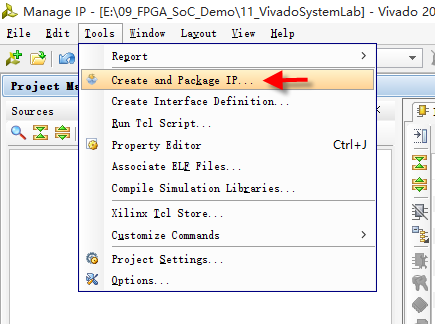
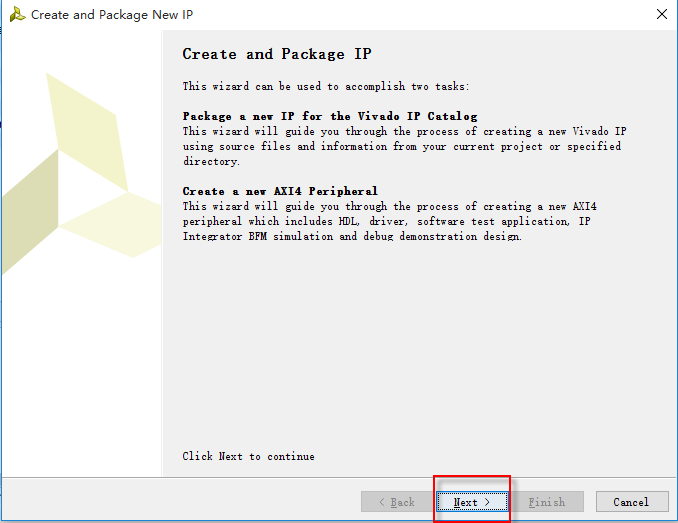
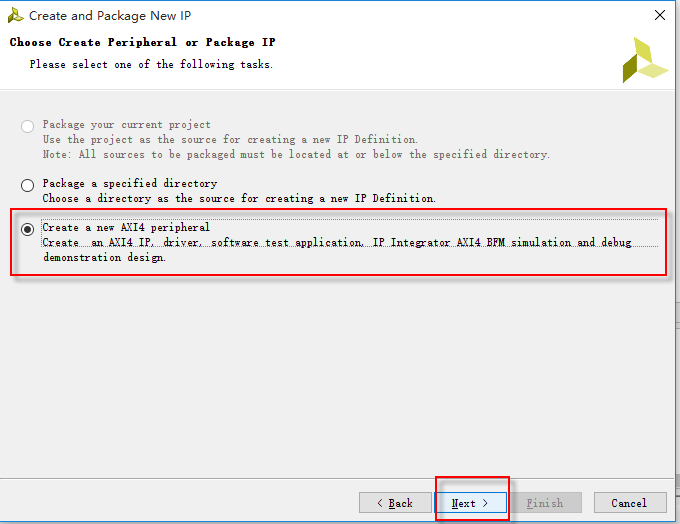
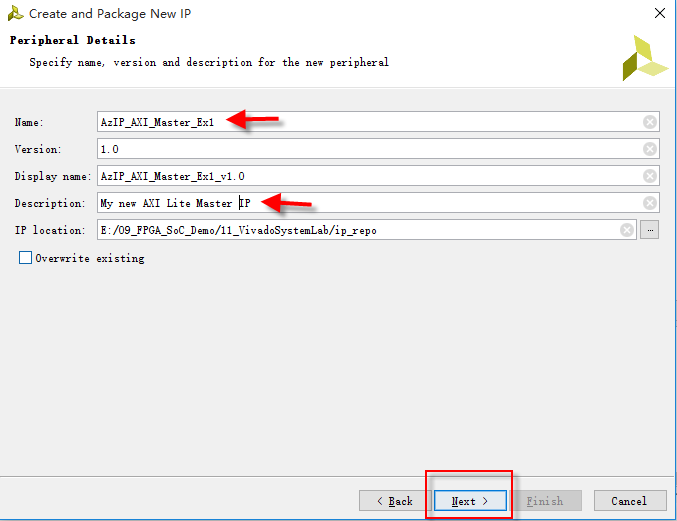
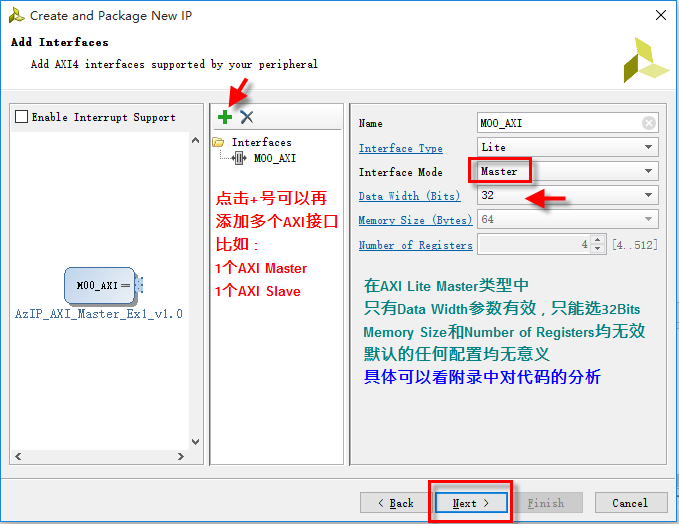




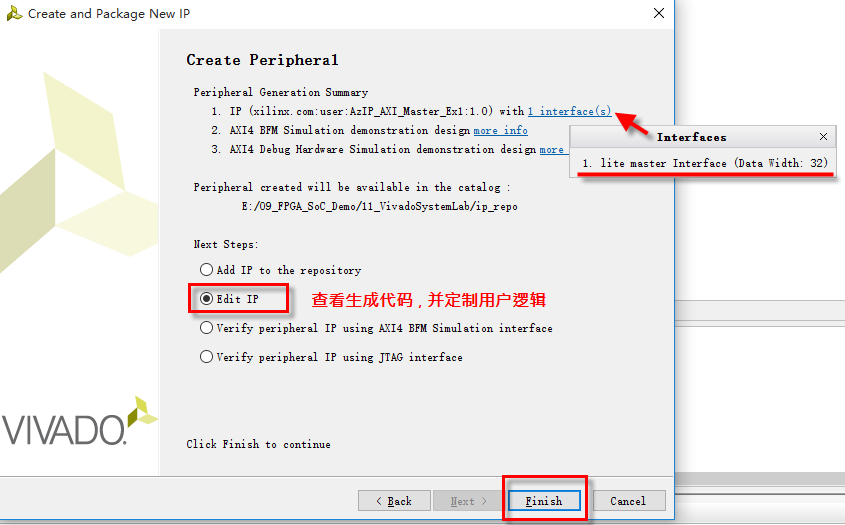
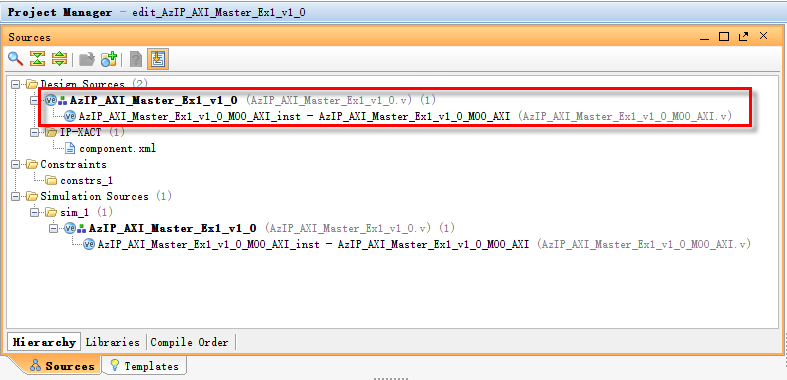
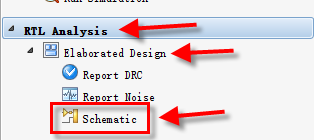
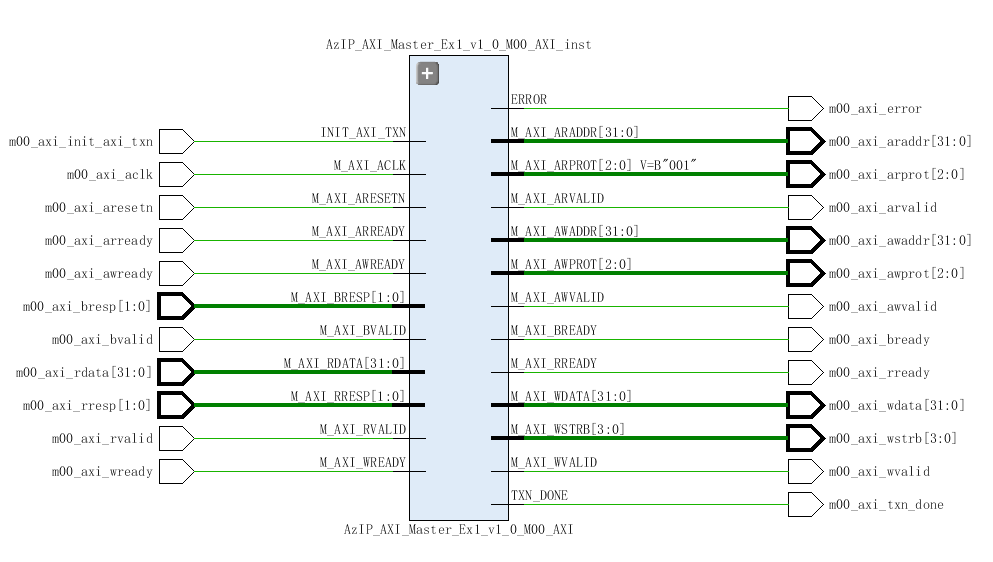
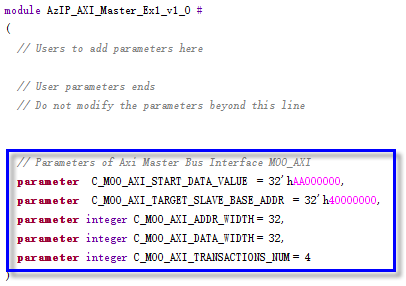
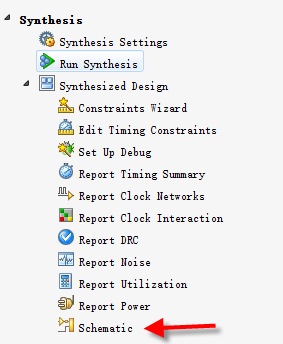
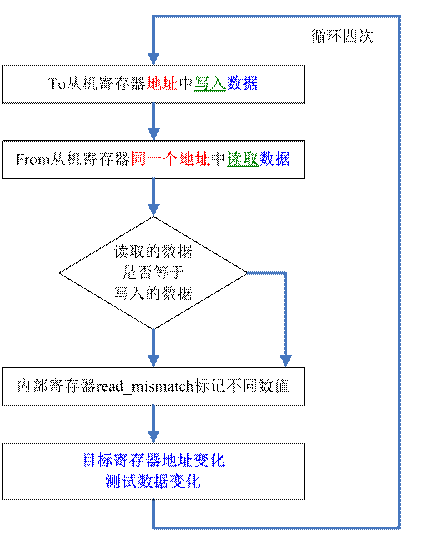
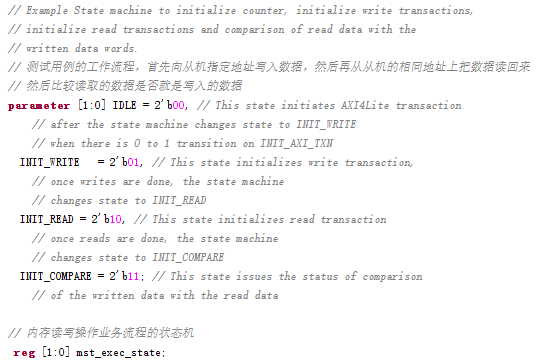


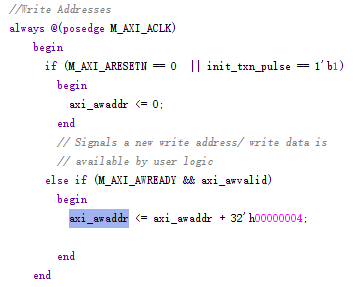


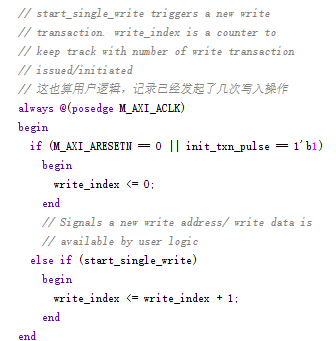
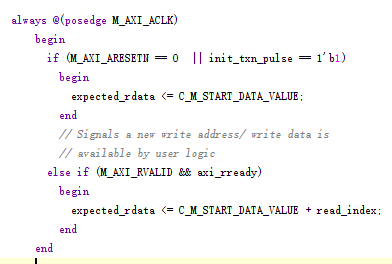
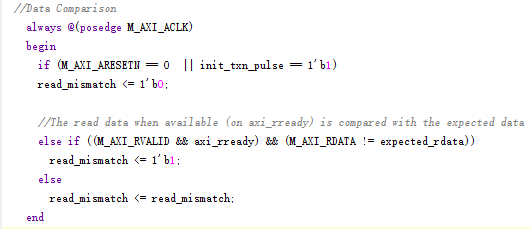
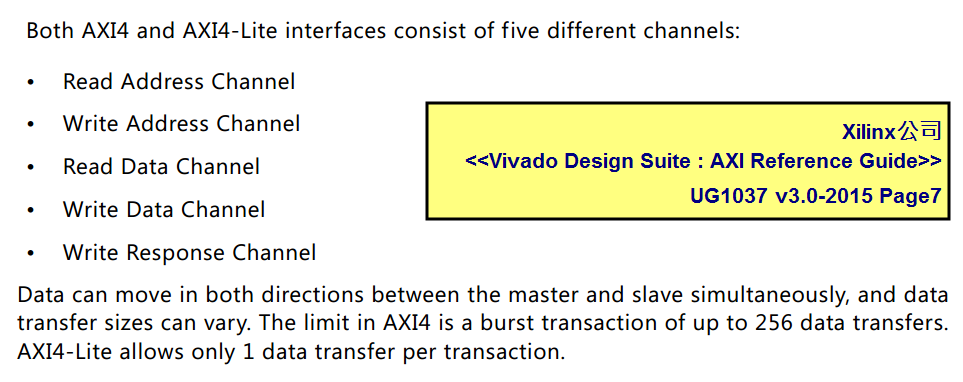
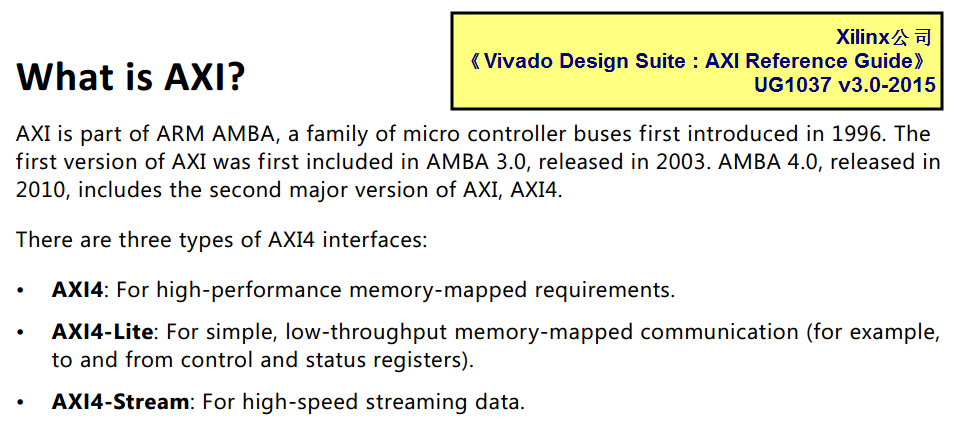
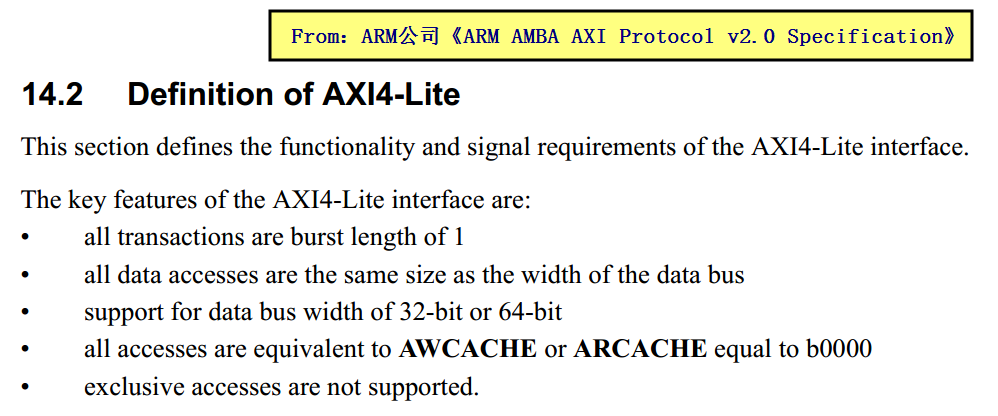


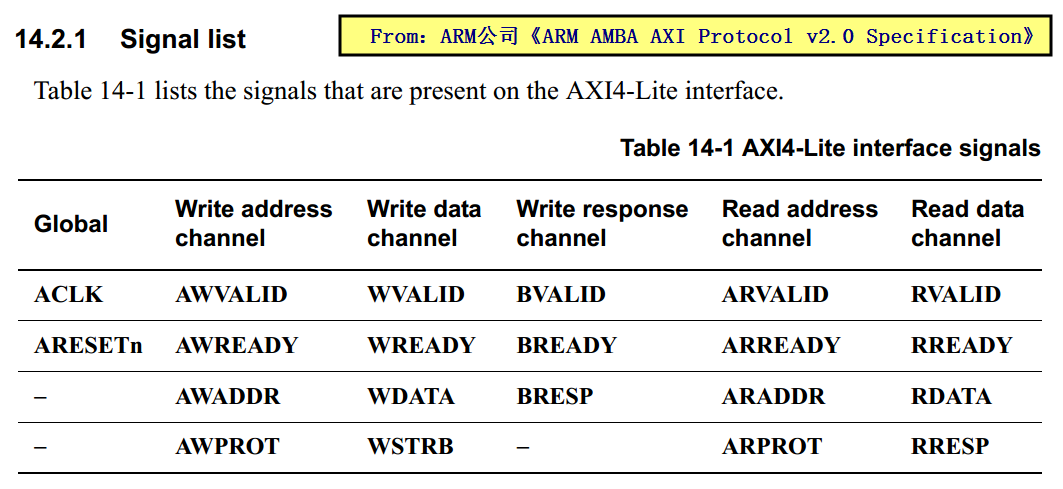
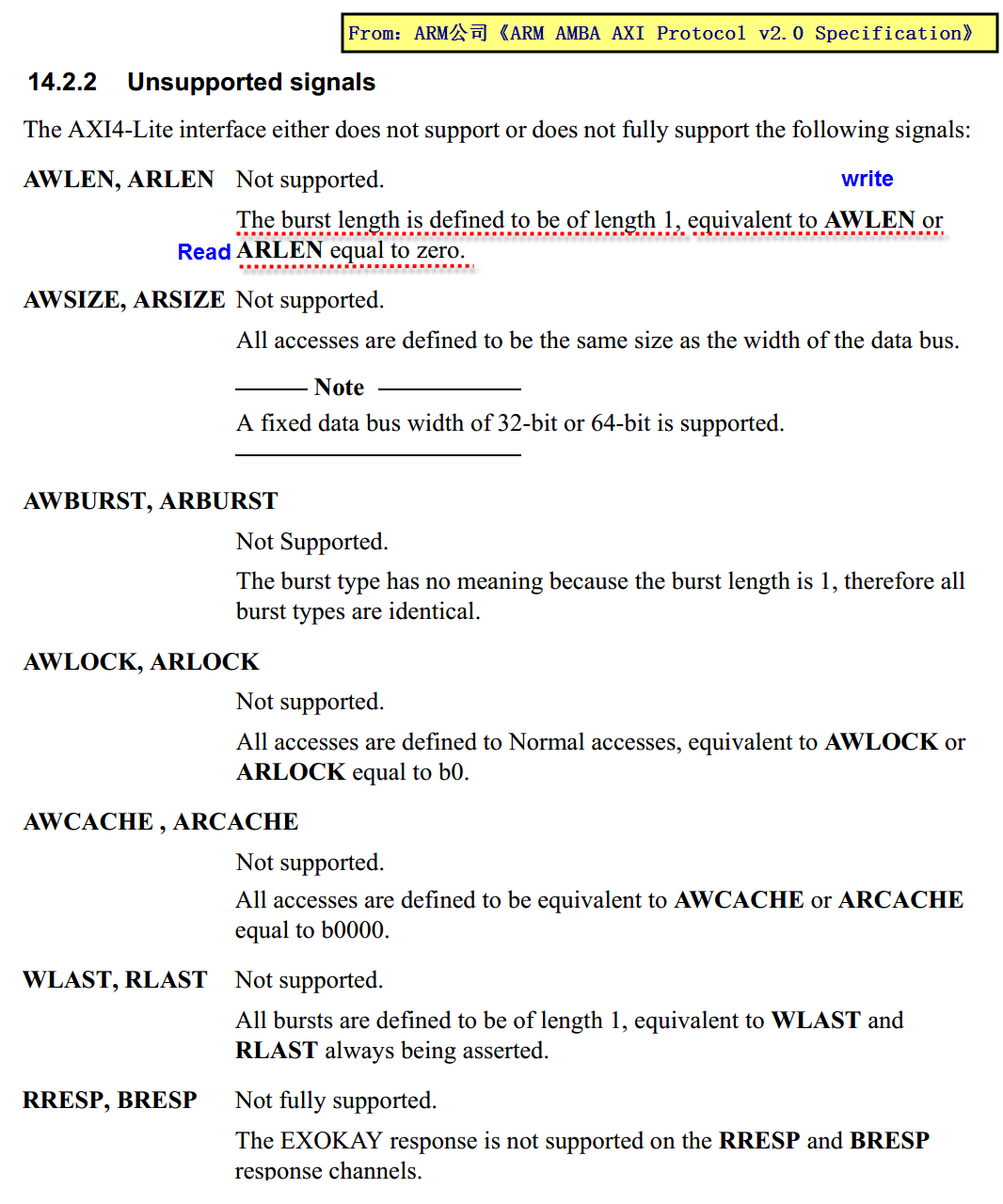
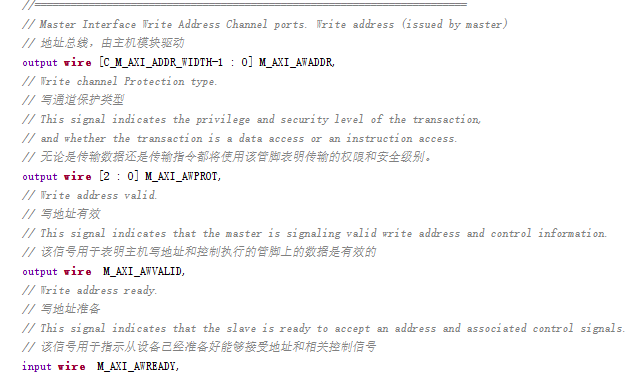

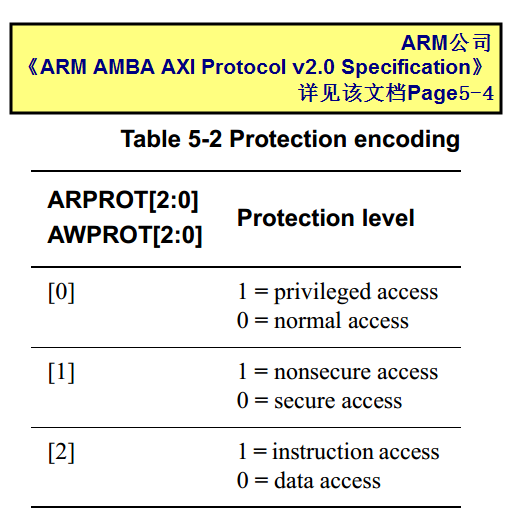
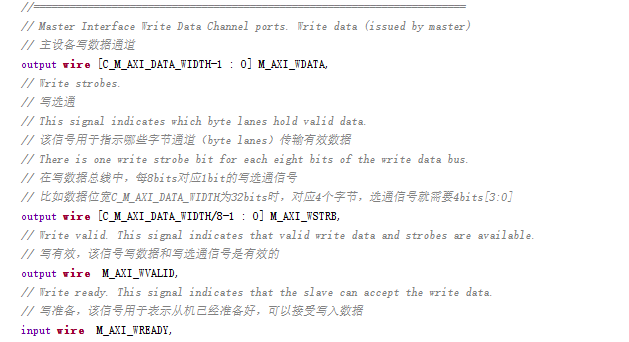
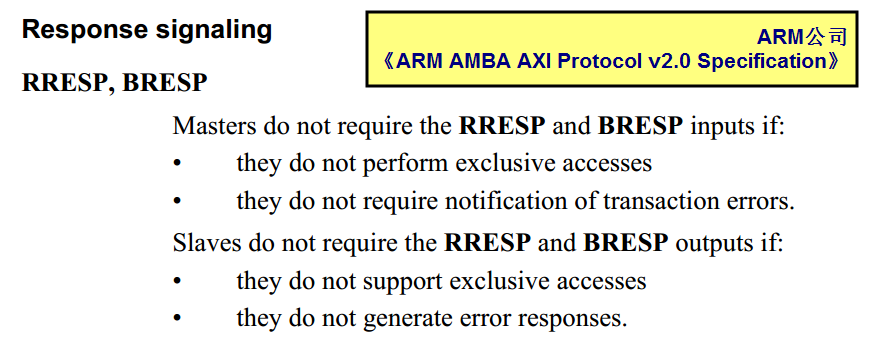
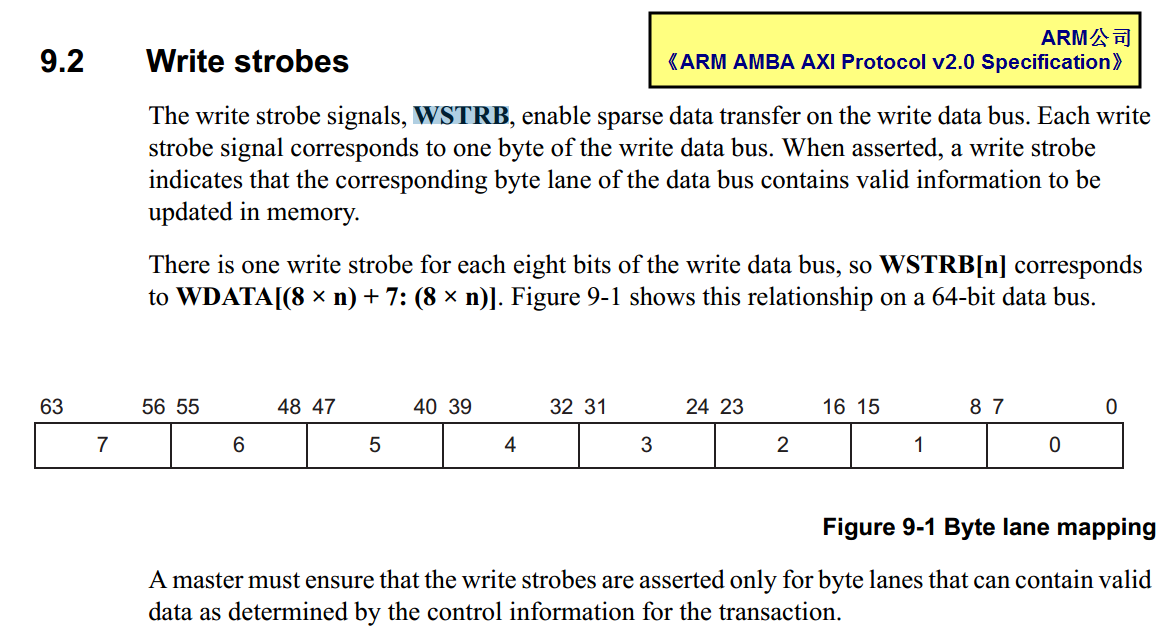
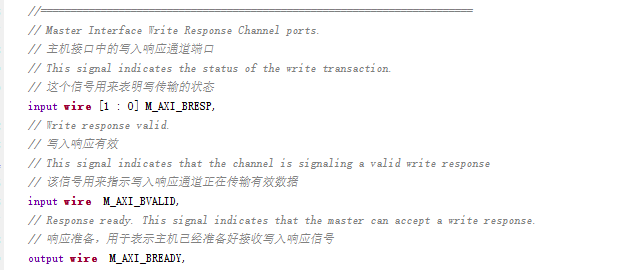
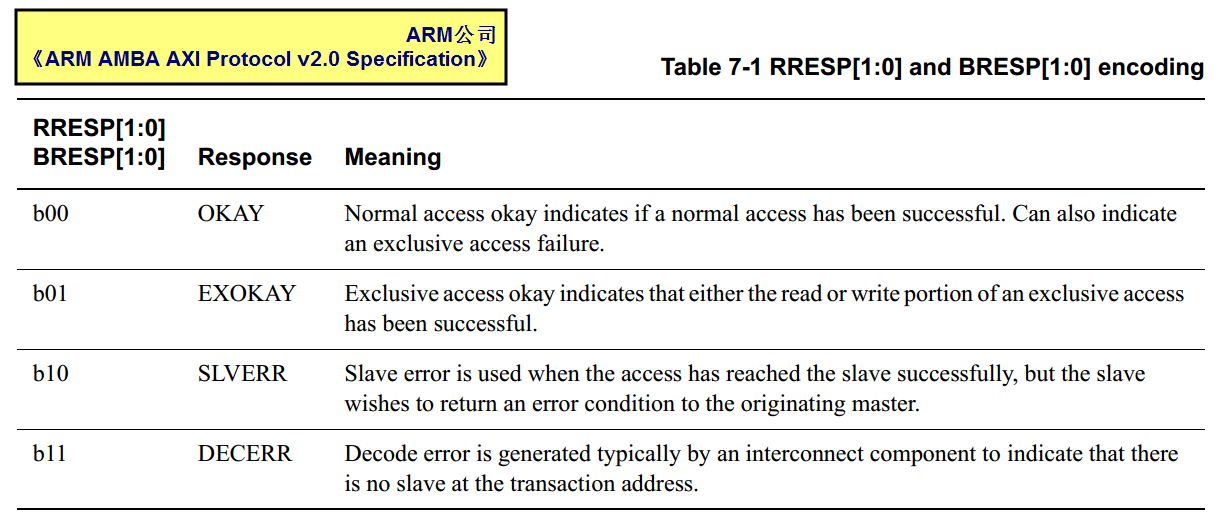
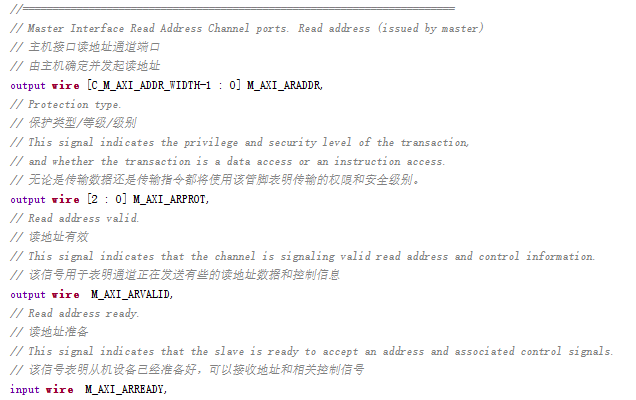
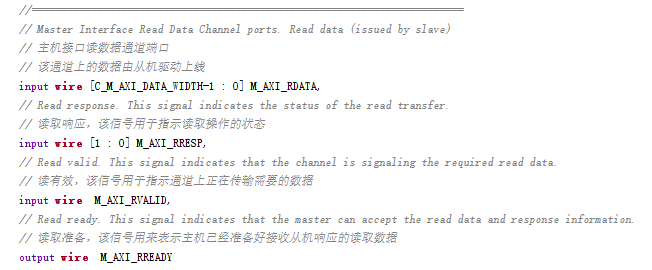
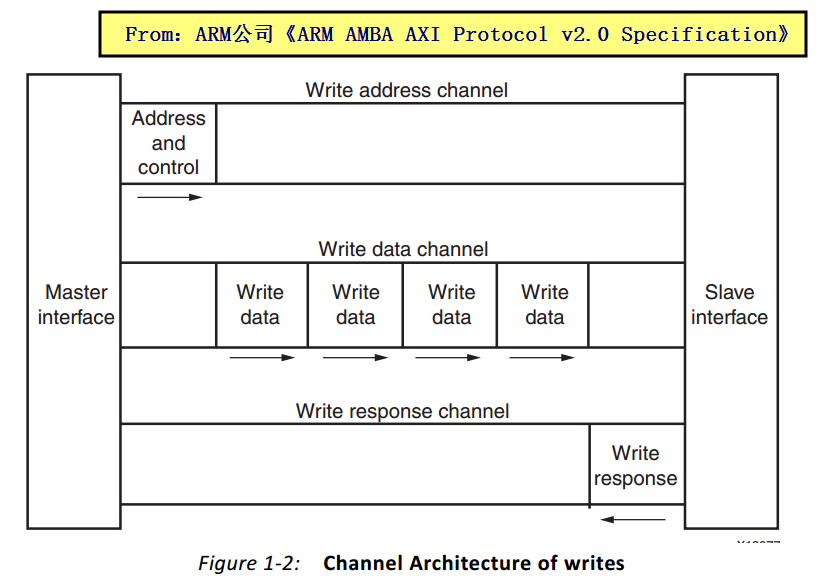
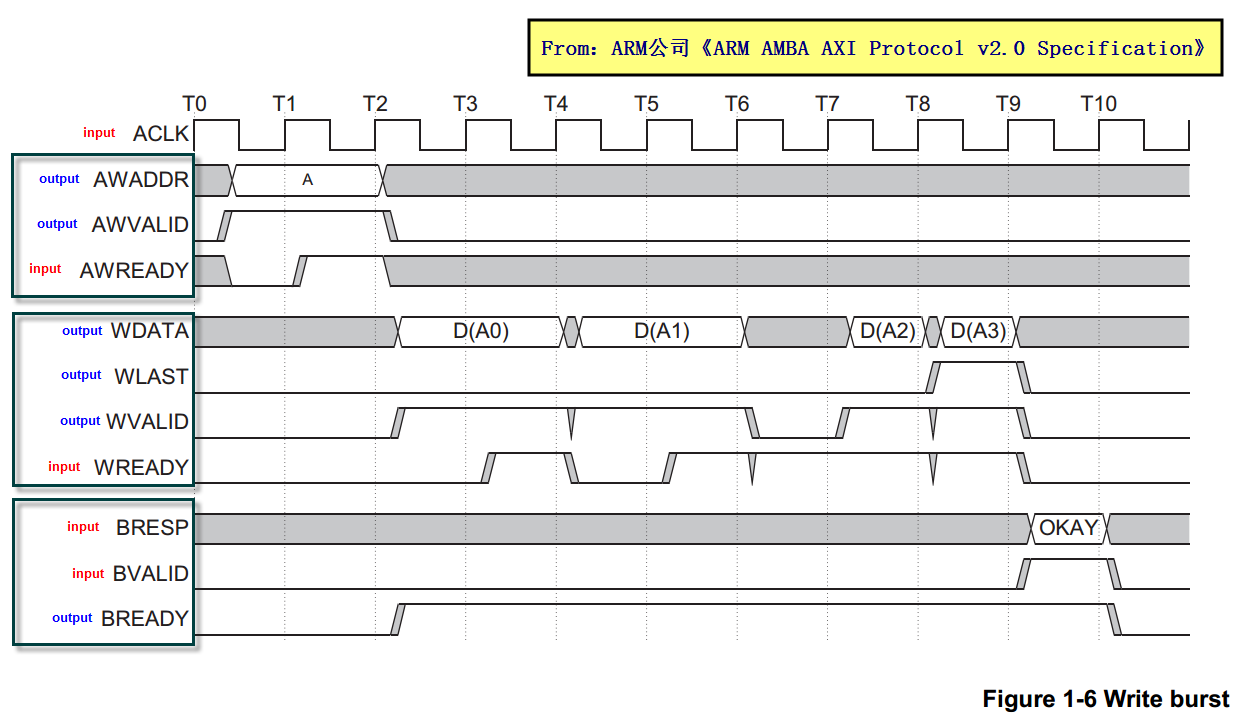
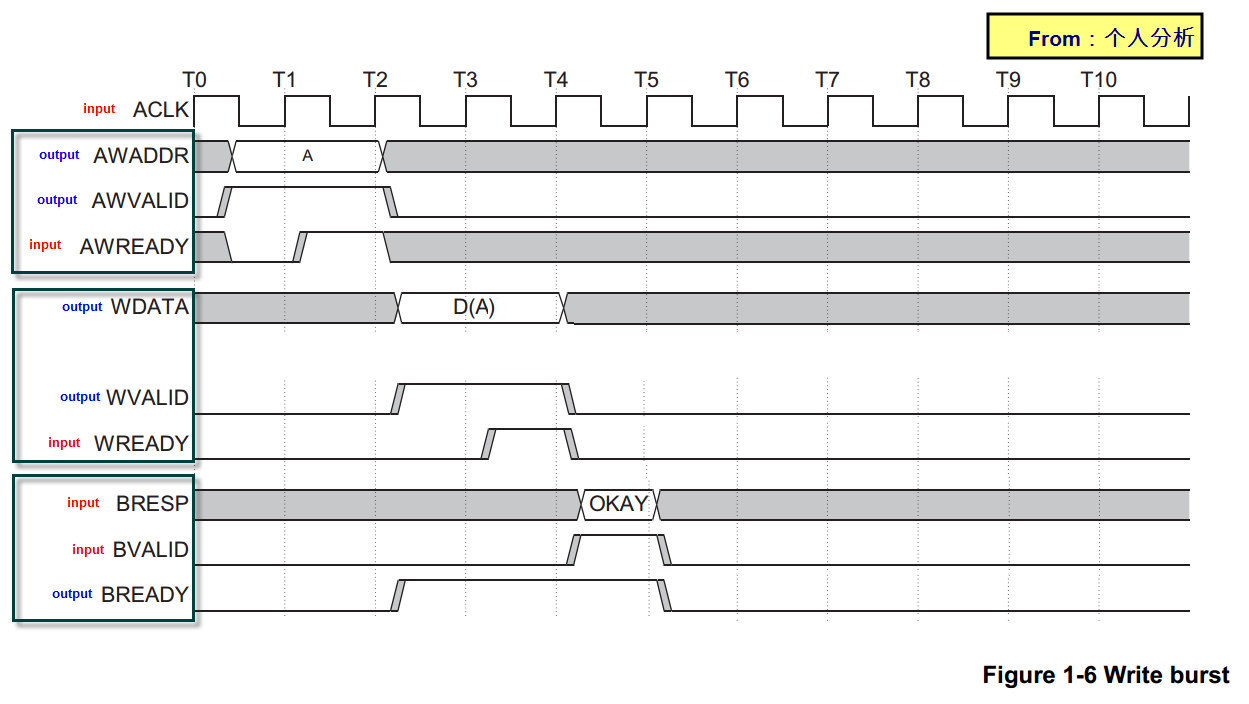
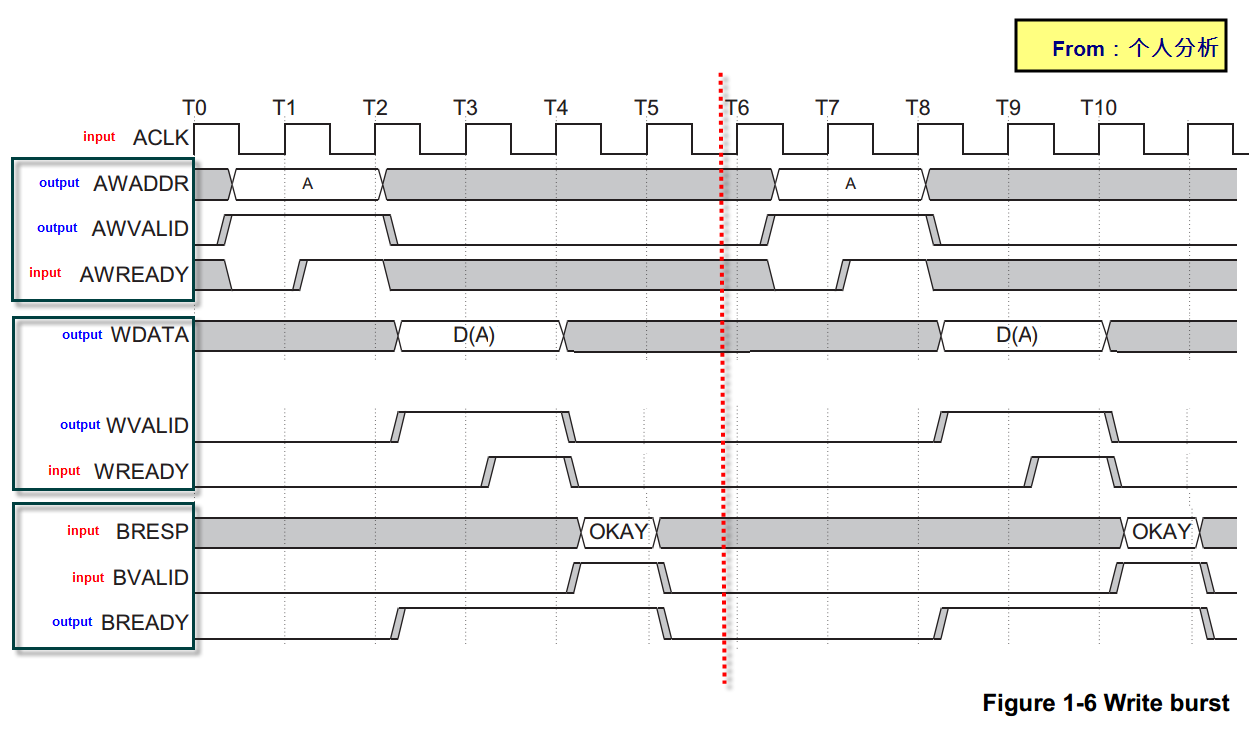
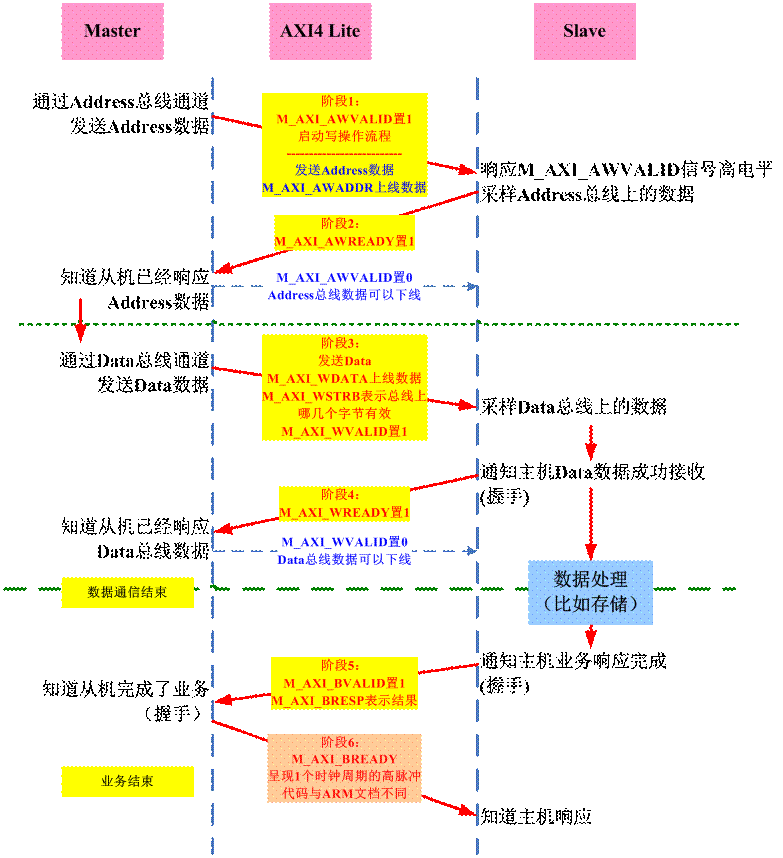
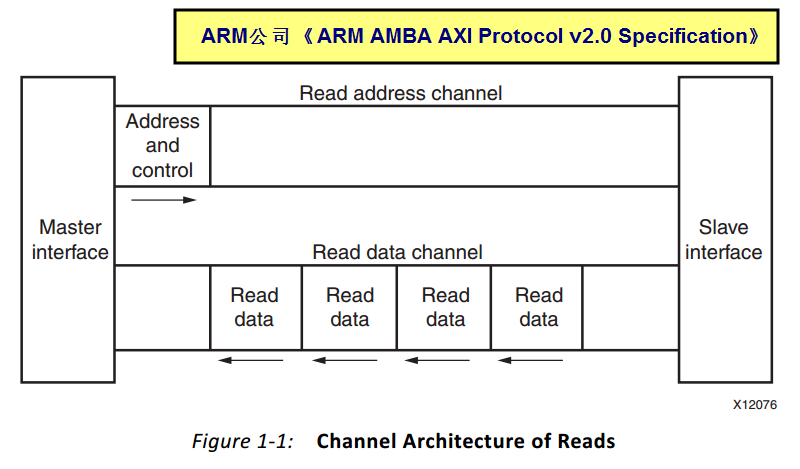

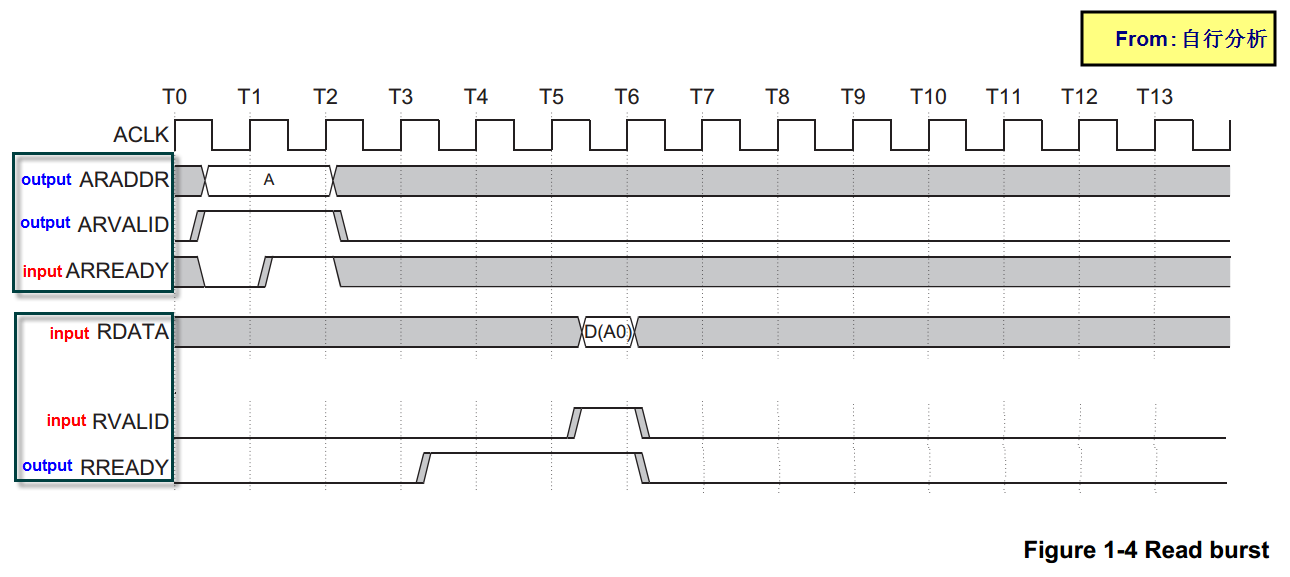
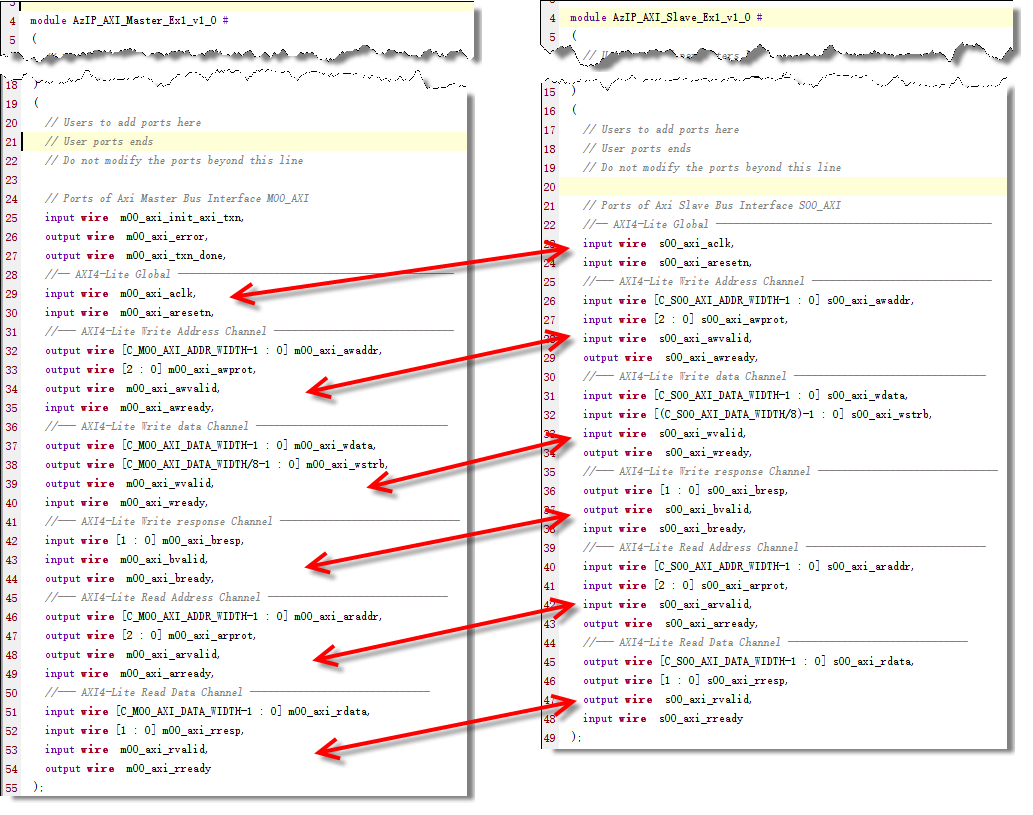

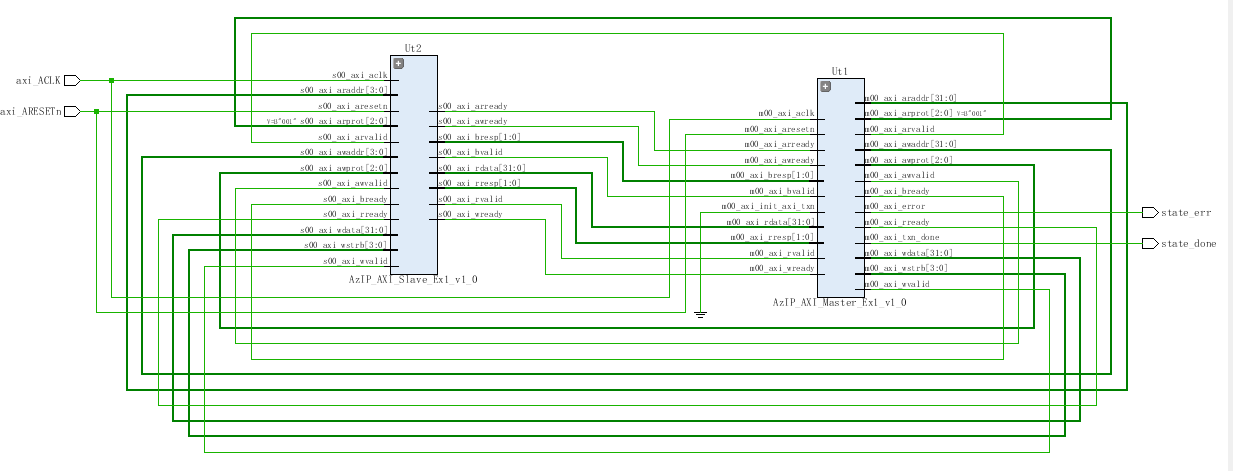
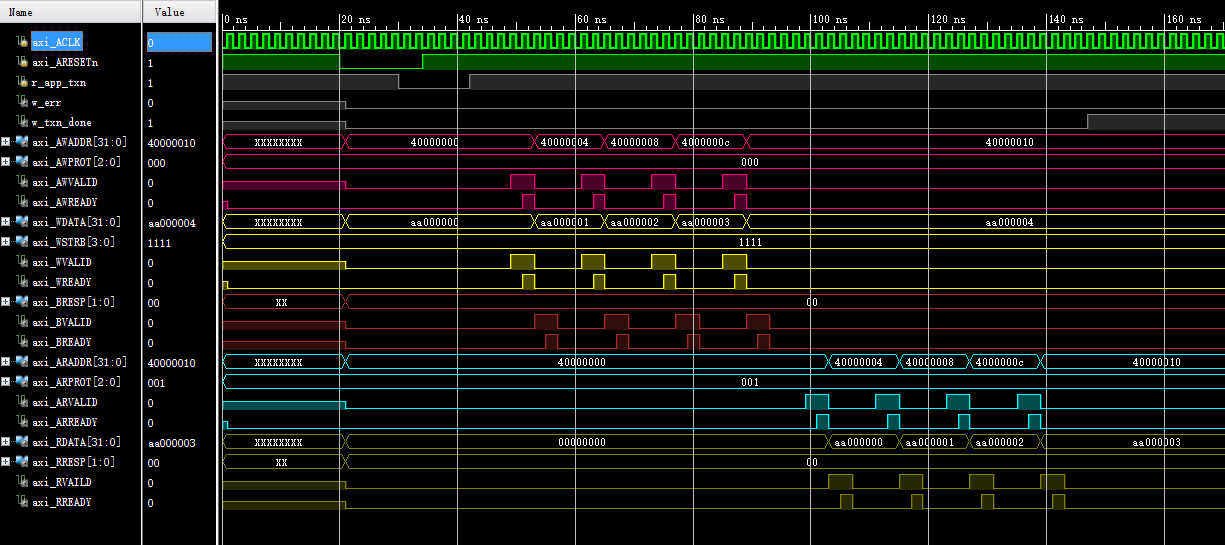


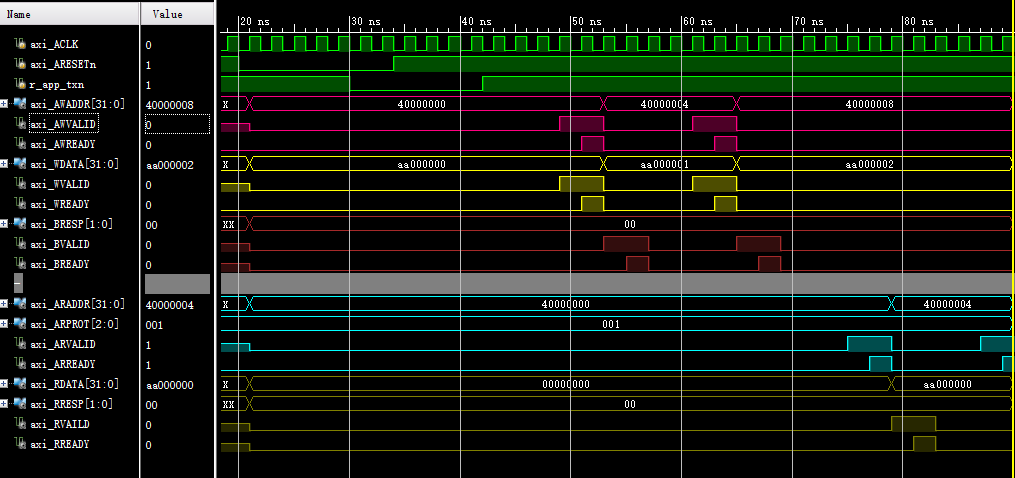
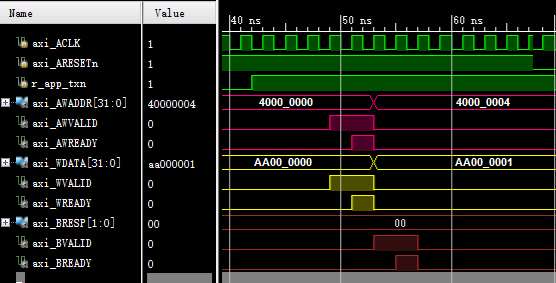















 555
555

 被折叠的 条评论
为什么被折叠?
被折叠的 条评论
为什么被折叠?








